Feed aggregator
One of the Finest Achievements of Heroic Fantasy in the 20th Century: Dilvish, the Damned by Roger Zelazny
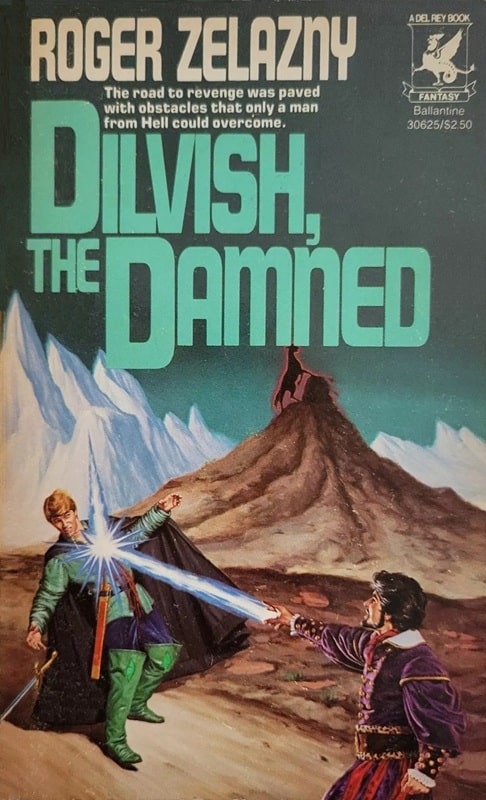
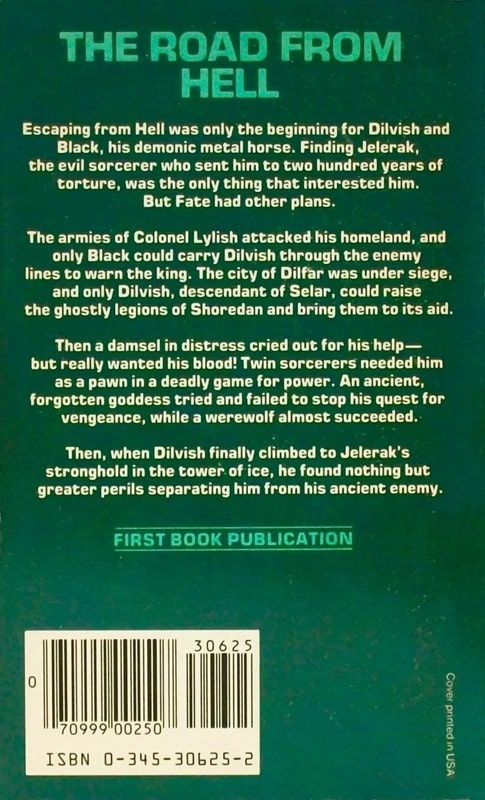
Dilvish, the Damned (Del Rey, November 1982). Cover by Michael Herring
Roger Zelazny was unquestionably one of the great American fantasists of the 20th century. That’s not to say he was perfect. His woman characters were often 2-dimensional, and he paired an unwillingness to work with an outline (“Trust your demon” was his motto) with a fondness for projects that really needed an outline.
But perfection is boring. Zelazny rarely is. Much of Zelazny’s work is on my always-reread list, anyway. He had a nifty way of putting things, and in describing the Amber series he brilliantly expressed the kind of fiction I love best and have often tried to write: “philosophic romance, shot through with elements of horror and morbidity.” Philoromhorrmorbpunk. That’s my genre. Or you could just say sword-and-sorcery.
Some people doubt whether Zelazny counts as a sword-and-sorcery writer, but he didn’t doubt it. He described not only the Corwin novels but also big chunks of Lord of Light as sword-and-sorcery. Some people think that a story only counts as S&S if it has a Clonan at its center, but as far as I’m concerned, if you’ve got an outsider hero on a personal mission in a landscape of magical adventure, and there are swords or other edged weapons, you’ve got sword-and-sorcery.
It doesn’t matter if it’s set in the deep future (e.g. Vance’s stories of the Dying Earth), or in an imaginary past (e.g. REH’s pioneering stories about Solomon Kane, Kull, Conan etc, but also C.L. Moore’s Jirel of Joiry and Cabell’s tales of Poictesme), or another world (e.g. Leiber’s Fafhrd and the Gray Mouser series).
And, anyway, Zelazny obviously counts as a sword-and-sorcery writer because of the Dilvish series. In some ways, it’s one of the finest achievements of heroic fantasy in the 20th century. In some ways, not. Details (a lot of them) ahead.
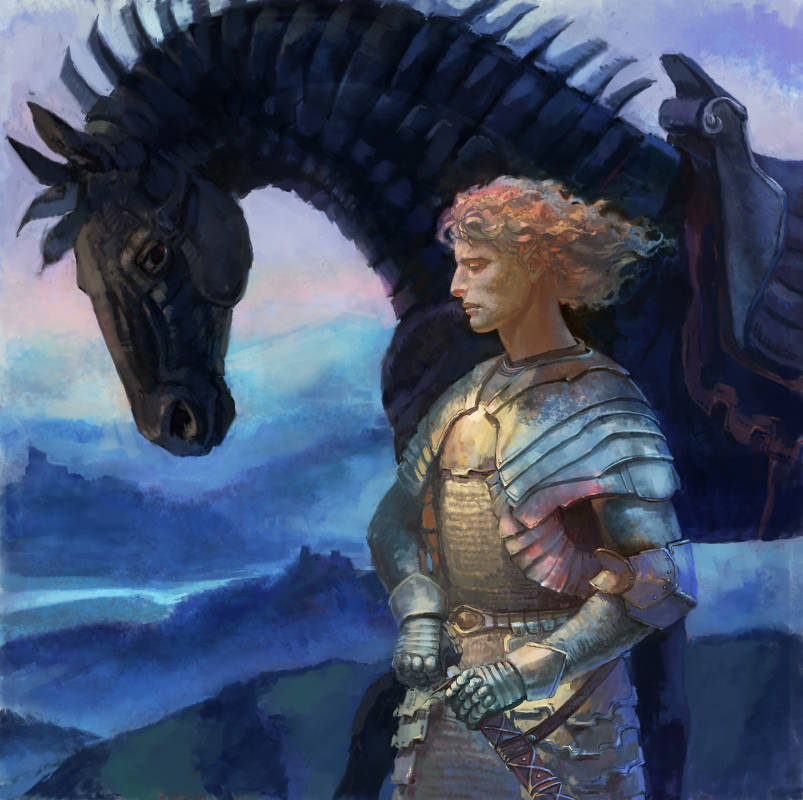 “Dilvish and Black,” fan art by Olga Sluchanko. Dilvish never had a cover painting this good in his damned life.
“Dilvish and Black,” fan art by Olga Sluchanko. Dilvish never had a cover painting this good in his damned life.
Dilvish, a.k.a. Dilvish the Damned, a.k.a. the Colonel of the East, first appeared in Fantastic under the guiding light of Cele Goldsmith, one of the great sf/f editors. After Goldsmith left the helm of Fantastic and Amazing, Zelazny continued to appear in those magazines, until he fell out with their new owner, Sol Cohen.
From that point Dilvish went into exile, the condition most natural for s&s heroes. He made appearances in a fanzine here, a small-press publication there. Zelazny’s hazy plan was to bring out a volume of Dilvish stories “to culminate in a possible novel, Nine Black Doves.” (Letter from Zelazny, 1965, quoted in the afterword to “Thelinde’s Song” in Power & Light.) When the Dilvish collection ultimately appeared from Del Rey in 1982, it was called Dilvish the Damned and it was paired with a booklength Dilvish adventure, The Changing Land.
A real golden age for Dilvish fans (which I had been since reading “The Bells of Shoredan” in a back-issue of Fantastic sometime in the mid-70s).
Or: maybe not.
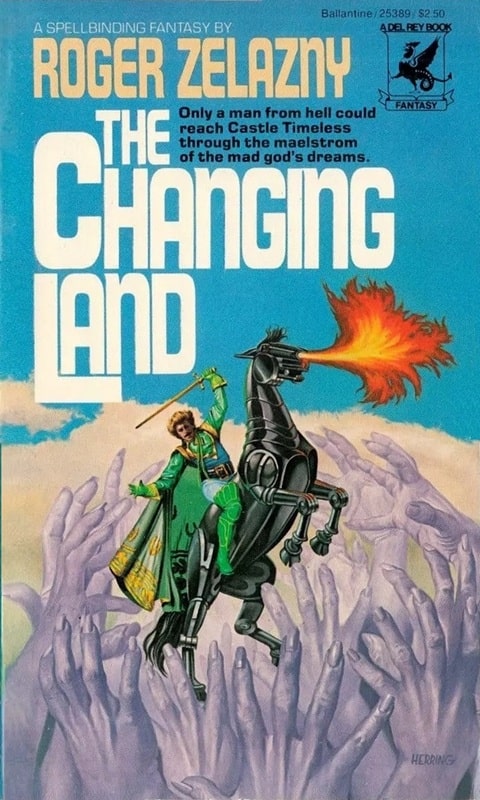
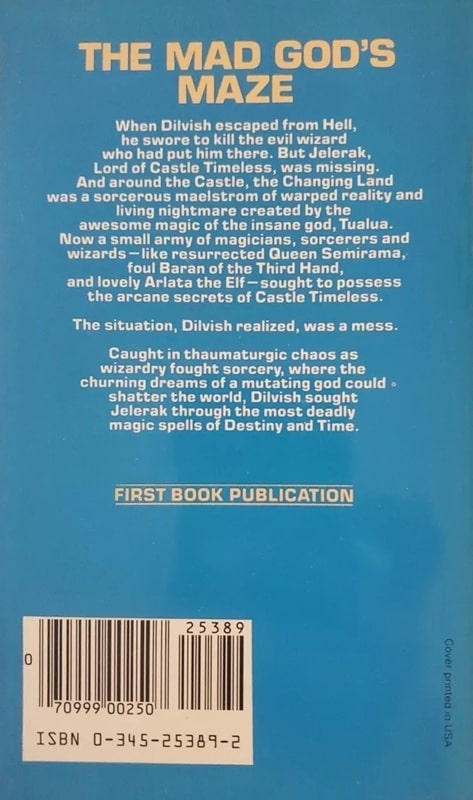
The Changing Land (Del Rey, April 1981). Cover by Michael Herring
I didn’t glom onto these books as soon as they were published; I’d been drifting away from buying books as my life became nomadic (and chaotic) in my early 20s. When I did finally get hold of the volumes I was, to say the least, underwhelmed. I wasn’t crazy about the covers, for one thing. Michael Herring is a talented artist, but I like his work better for sf; these covers are kind of Brothers-Hildebrandtish. (From some, that would be praise, but not from me. De gustibus non disputandum.)
I also didn’t like the titles: Nine Black Doves is weird and evocative; Dilvish the Damned and The Changing Land are blunt and dull declarations, like a can of peas with a generic black-and-white label PEAS.
But a book by Zelazny is a book by Zelazny, so I bought both paperbacks when I had a chance… and was not crazy about them.
“Even Homer nods,” I said to myself, and put them in a box somewhere.
When NESFA Press, that beacon of glory in sf/f publishing, produced its monumental series collecting all of Zelazny’s short fiction (Grubbs, Kovacs, and Crimmins ed.), of course I seized on the volumes as soon as I could, read them through, and loved them furiously.
 The Collected Stories of Roger Zelazny, all six volumes (NESFA Press, February – December, 2009). Covers by Michael Whelan
The Collected Stories of Roger Zelazny, all six volumes (NESFA Press, February – December, 2009). Covers by Michael Whelan
There were expected and unexpected pleasures in these volumes, but one of the surprises was how much I liked some of the Dilvish stories, tarnished in my fading memory by that 80s-era read. “I should reread the whole set of Dilvish stories together sometime,” I thought.
That was fifteen years ago, so maybe it’s time.
My executive summary, in case you don’t have the patience to read through these notes, is that the Dilvish stories contain some of Zelazny’s best writing, and some of his worst. My initial, uneasy thought was that the early stories were good and the later stories were bad, but that turned out to be too simplistic; one of the last Dilvish stories he wrote is maybe the single best thing in the two Dilvish books.
I reread the stories in the electronic version of the NESFA Collected Stories, which I recommend even more strongly than the original edition, because the editors have continued to revise and proofread the books. The design of the collections is to include the stories in the order they were composed, to the extent that can be ascertained, but they bend that rule when one story was written to provide backstory for another. (Which is exactly the right attitude toward rules. Rules should be governed by intelligence, not vice versa.)
Is Dilvish the Damned a novel or a collection of stories? I suppose I could waive the question, since I’m rereading the stories individually. But it’s a live question for work like this — a series of connected stories read as a whole. Lots of people call these things “fix-ups,” because that’s what Van Vogt called it when he smashed the bizarrely square pegs of his 1940s stories into the boring round holes of his 1950s paperback originals.
I don’t like the term because I hate Van Vogt’s fix-ups, and I also think that the best examples of this form (e.g. Leiber’s F&G volumes for Ace, or the various collections of C.L. Moore’s Jirel and Northwest Smith stories, or Howard Andrew Jones’ Hanuvar novels) don’t replicate Van Vogt’s mistakes: they respect the original stories, even when they create connective tissue to string the stories together. I call this kind of thing an episodic novel, and keep hoping that the term will catch on.
Whatever this thing is, here’s what I thought of it. (YMMV; de gustibus non disputandum; objects in mirror may be closer than they appear; etc.) This is already getting to be pretty long, so I’ll defer my thoughts about The Changing Land to another time (if ever).
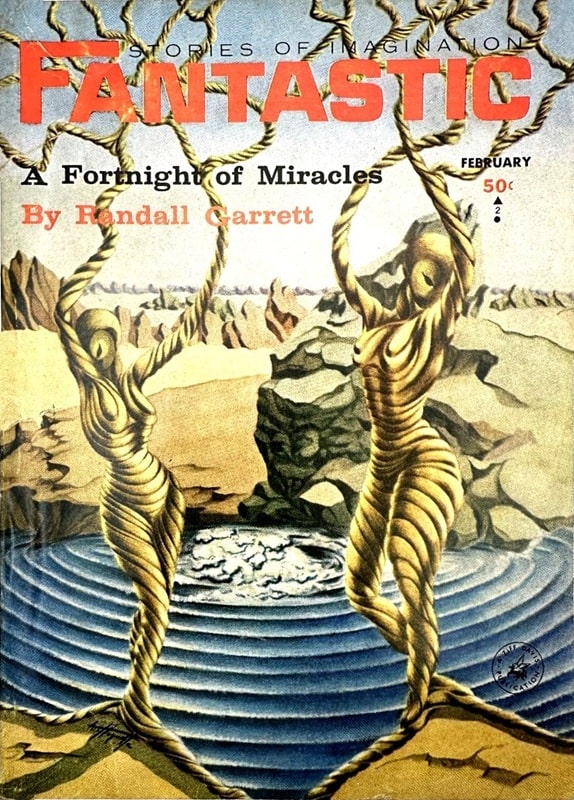 Fantastic Stories of Imagination, February 1965, containing the first Dilvish story, “Passage to Dilfar.” Cover by Heidi Coquette
1. “Passage to Dilfar” (1965, approx 2,000 words)
Fantastic Stories of Imagination, February 1965, containing the first Dilvish story, “Passage to Dilfar.” Cover by Heidi Coquette
1. “Passage to Dilfar” (1965, approx 2,000 words)
We meet Dilvish, already in progress, riding a horse made of steel named Black, “for whom it was said the Colonel of the East had bartered a part of his soul.” They are fleeing from a place called Portaroy, pursued by horseman sent by Lylish, Colonel of the West. (Dilvish himself is the aforesaid Colonel of the East.) Through hazards mundane and magical, they make their way to Dilfar, in the hopes that this city will withstand the onslaught of Lylish’s armies.
This is a very short story, approx 2,000 words, but it packs a strong, fantastical punch. It suggests a world far larger than anything it depicts. Zelazny claimed that he never intended to write a sequel, but Editor Goldsmith said it “begs for a series”, so Zelazny obliged. In fact, he started to plan a series of adventures, maybe to be capped with a novel called Nine Black Doves.
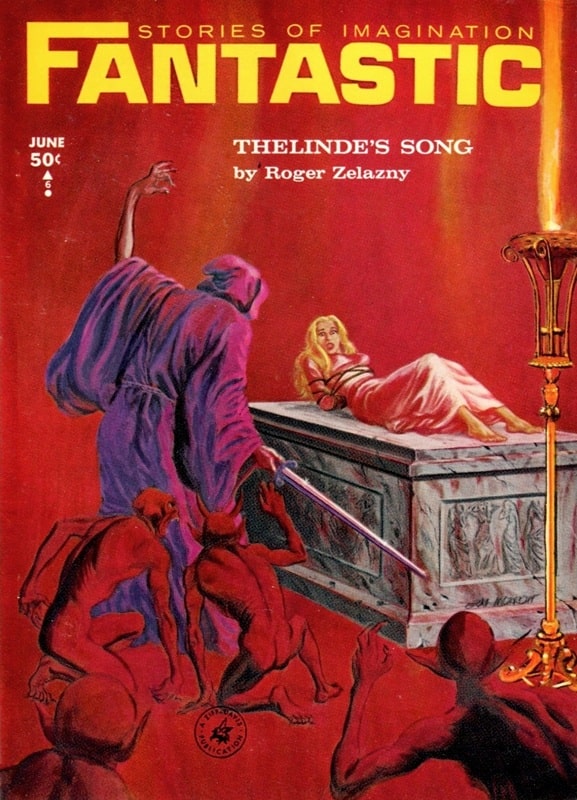 Fantastic Stories of Imagination, June 1965. Cover by Gray Morrow, illustrating “Thelinde’s Song.”
2. “Thelinde’s Song” (1965; approx 2,800 words)
Fantastic Stories of Imagination, June 1965. Cover by Gray Morrow, illustrating “Thelinde’s Song.”
2. “Thelinde’s Song” (1965; approx 2,800 words)
If you’re expecting an epic account of the defense of Dilfar against the slavering hordes of the Colonel of the West, that’s not where Zelazny is headed. There was such a defense, and it’s mentioned in passing here, including Dilvish’s final encounter with the warrior he met and bested (sort of) in the previous story.
But Dilvish himself doesn’t even appear as a character in this story, which is a conversation between the titular Thelinde and her witch-mother Mildin. Mildin explains the half-elven background of Dilvish, his victory in defending Portaroy in the old time, his magic green elf-boots, and his enmity with the evil and powerful wizard Jelerak.
Jelerak was using evil magic to evilly draw the youth out of a maiden; Dilvish tried to disrupt the ceremony; Jelerak changed Dilvish’s body to a statue and sent his soul to Hell. There Dilvish suffered for centuries, but now he’s escaped with a demonic horse named Black and Jelerak, with all his power, now has something to worry about.
This story isn’t much longer than “Passage to Dilfar.” Where “Passage” was all action, this is all exposition, and at times it seems like Zelazny has a list of things he wants his mouthpiece to talk about (e.g. Dilvish’s green elf-boots, magical equipment which you would think would affect the stories a lot, but usually do not). Still, this quasi-story is vivid and impactful and sketches in details about Dilvish and his world that make them loom even larger in the imagination.
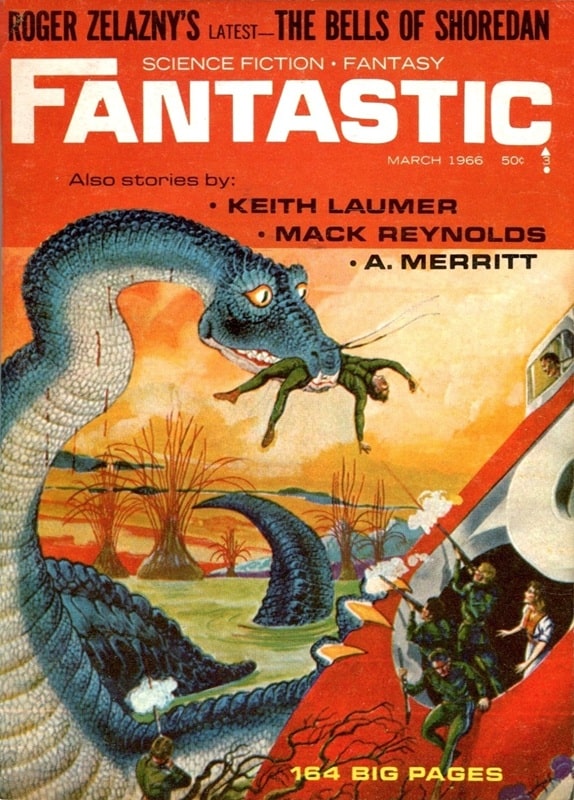 Fantastic, March 1966, containing “The Bells of Shoredan.” Cover by Frank R. Paul
3. “The Bells of Shoredan” (1966; approx 6,200 words)
Fantastic, March 1966, containing “The Bells of Shoredan.” Cover by Frank R. Paul
3. “The Bells of Shoredan” (1966; approx 6,200 words)
In this much longer story, Dilvish goes to the ruined city of Shoredan to ring its bells and summon its legions of the dead to fight against the Colonel of the West. On the way he must confront the ghost of his Elvish forebear Selar and the demon who tortured Dilvish in Hell, Cal-den. On the way he acquires the invisible blade of Selar.
If you like this kind of thing, you will like this story a lot. A sword-and-sorcery classic. If you read only one Dilvish story, it should be this one.
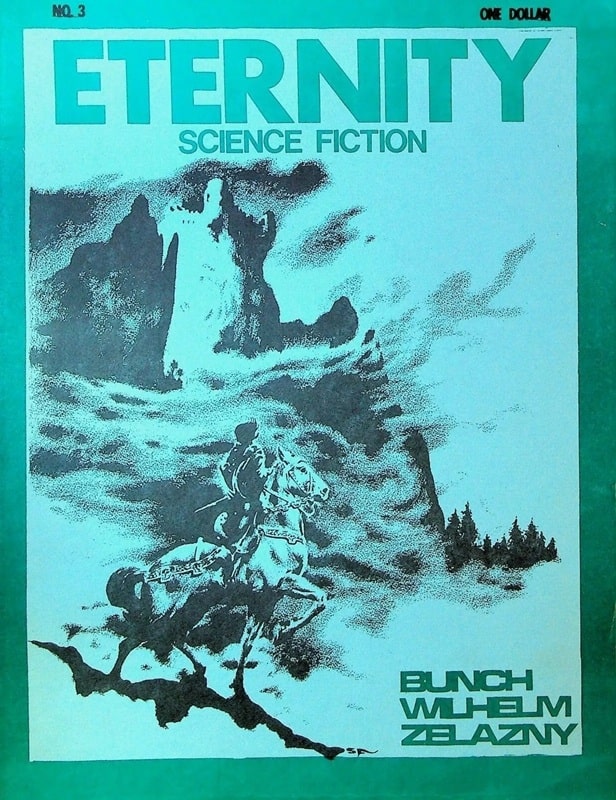 Eternity Science Fiction #3, 1974, containing “A Knight for Merytha.” Cover by Stephen Fabian
4. “A Knight for Merytha” (1967; approx 3,000 words)
Eternity Science Fiction #3, 1974, containing “A Knight for Merytha.” Cover by Stephen Fabian
4. “A Knight for Merytha” (1967; approx 3,000 words)
Again, where an epic fantasist would zig (i.e. follow up the previous story by describing the battle of the dead against Lylish), Zelazny zags. We catch up with Dilvish for a solo adventure as he travels alone with his steel horse and demonic sidekick Black.
And, if you were expecting more progress on the Jelerak plotline, that doesn’t happen either. Zelazny later described Dilvish as a man obsessed with revenge, but that isn’t clear in the actual stories. Jelerak isn’t mentioned at all in the first Dilvish story, or in this one, where he is scouting ahead of the “doomed army” he summoned to defeat Lylish.
Like a knight sans peur et sans reproche, Dilvish responds to the cry of a woman in distress (even though his wily steed warns him against it). If you think you know where this story is going, you probably do, but it’s a solid fantasy adventure involving a vampire. Sword-and-sorcery meets Hammer Horror. Cast Ingrid Pitt as Merytha and you’ve got it.
One particular detail that struck me about this story — more a worldmaking question than an issue with the story itself — is the use of the invisible sword of Selar (which Zelazny acquired in “Shoredan”). It’s hard to see (wokka-wokka-wokka) how such a sword would actually be useful. No doubt there’s a surprise factor when you approach your foe armed, but apparently empty handed. But how do you fight with it? You, as much as your opponent, need to know where your point is so you can stab him with it. There’s a great series of movies about a blind swordsman Zatoichi, but on film that stuff works because your eye sees it and the mind accepts it.
It wasn’t clear to me what skills Dilvish had or developed to make use of the invisible blade. Zelazny was a fencer and pursued a number of different martial arts and he may have had ideas about it, but the invisible blade disappears after this story, along with Lylish and the defense of Dilfar.
“A Knight for Merytha” originally appeared in a fanzine and was the last of the Dilvish stories for a while. Zelazny wasn’t sending his work to Fantastic or Amazing anymore, due to his quarrel with their new publisher, and when he got the sword-and-sorcery itch he would write about other characters — Sam the Buddha and his pseudo-divine frenemies, or Corwin of Amber and his quasi-divine familenemies.
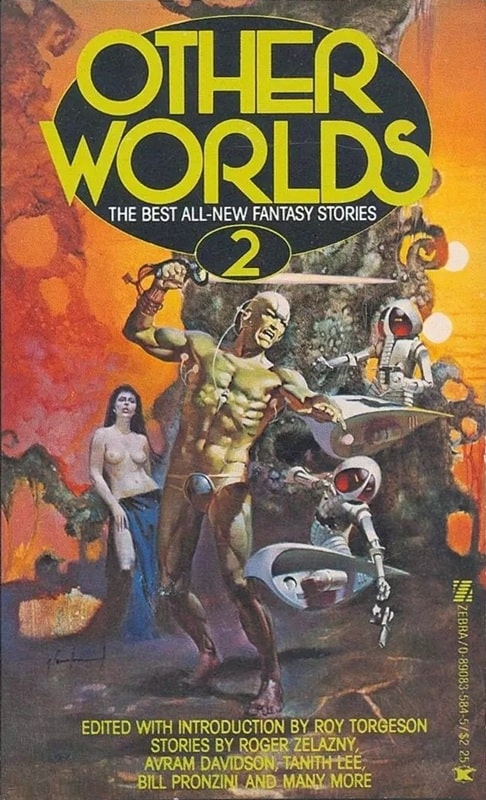

Other Worlds 2, edited by Roy Torgeson, containing
“The Places of Aache” (Zebra, January 1980). Cover by Jordi Penalva
We again find Dilvish wandering through strange lands alone (except for his faithful Black). He runs into a would-be robber who’s disconcerted by Dilvish’s militant response. The robber thinks he has protection from a local goddess, who authorizes his career of crime, but that doesn’t save him from Dilvish’s (non-invisible) sword.
Dilvish goes on to confront the sinister priest of the goddess, and the goddess herself. She’s a monstrous, many-limbed creature, and at this point you might expect an epic battle. What actually happens is that Aache (the monster-goddess) and Dilvish talk, and he figures out a solution for her particular set of problems. But there’s a menace lurking that neither of them expect, and the story ends on a tragic note.
This is a solid sword-and-sorcery adventure where the hero displays intelligence and compassion as well as ruthlessness and fighting skill. (The conversation between Dilvish and Rogis the robber is classic, Hammett-level tough-guy dialogue.)
There’s no mention of Jelerak here; there’s no mention of Lylish and the military conflict over Portaroy, Dilfar, etc.
6. “A City Divided” (1982)Originally published in Dilvish, the Damned.
We again find Dilvish wandering through strange lands alone (except for his faithful Black). (Yes I did just cut-and-paste that from the section above.) While travelling in the North Country, Dilvish falls into a city-sized trap, where a magical game is being played between two sorcerers. Dilvish’s fighting ability and Black’s infernal strength can’t get them out of this one, so Dilvish turns to magic — one of the twelve Awful Sayings that he learned in Hell.
There’s some good stuff here: conversations between Dilvish and Black, the depth of infernal lore suggested by a few strategic details, the conversation between Dilvish and the sorcerer Strodd at the end of the story.
But there’s also a lot of narrative busywork as Dilvish and Black try to negotiate the maze inside the city. Mazes are weird and perplexing when you’re in them, and that kind of experience films well (I’m thinking of a couple of very different scenes in The Stand and in Sleuth), but I don’t think it works well in fiction. Anyway, it didn’t work for me in this fiction.
The conflict with Lylish is mentioned (as completed in the past), and Jelerak is discussed at the end, including the place Dilvish expects to find him, the Tower of Ice. So there’s at least some attempt to fit this story into the over-arching plotline of the series.

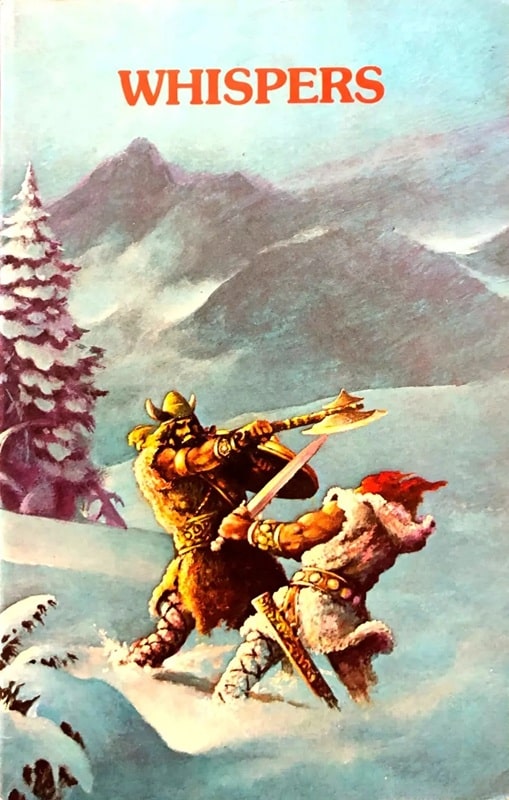
Whispers 2, October 1979, edited by Stuart David Schiff, containing “The White Beast.” Cover by Steve Fabian
We again find Dilvish wandering through strange lands alone (except for his faithful Black). My cut-and-paste notwithstanding, I don’t object to this generic type of beginning. Zelazny varies the descriptions to keep the thing interesting, and a sword-and-sorcery hero is usually a loner or at least an outsider. In this story, for instance, Dilvish’s name doesn’t appear until three-quarters of the way through this very short (approx, 1,200 words) story. He’s just described externally.
Now Dilvish is deep in the north, in a landscape of snow and ice, and he is being pursued through the icy wasteland by a white werebeast. Dilvish is not the guy to back away from a fight, but instead of killing the monster he offers to split his food with it. They engage in conversation and discover they have a common enemy.
This is only an episode, leading to the longest Dilvish story (except for the novel, The Changing Land), but it’s vivid and haunting.
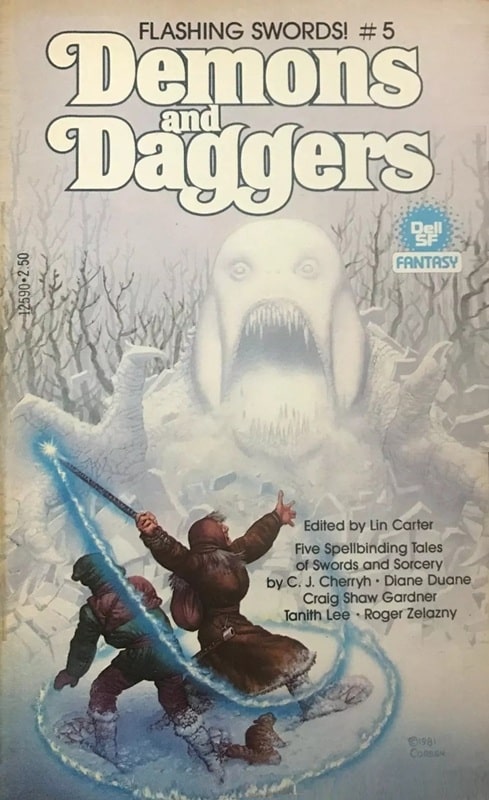
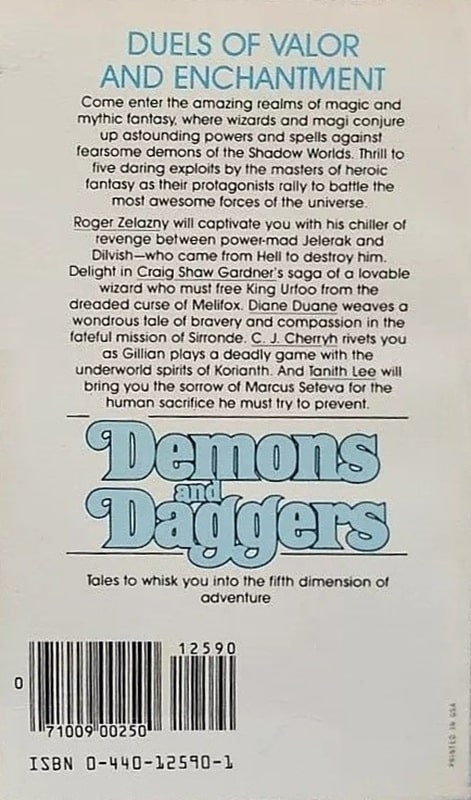
Flashing Swords! #5: Demons and Dagger, edited by Lin Carter,
containing “Tower of Ice” (Dell, December 1981). Cover by Richard Corben
We again find Dilvish wandering through strange lands alone (except for his faithful Black). But this is no mere random episode: Dilvish has finally reached one of Jelerak’s strongholds and hopes that he can have his long-sought-for confrontation with this Evil Wizard Who Is Evil… if he can just get into the damned place.
This is the longest of the Dilvish stories (except for the novel, The Changing Land). It was one that Zelazny had long planned on writing. And it is, in my view, the worst of the Dilvish stories (except for the novel, The Changing Land).
What went wrong? (If you love this story, you may be screaming “NOTHING!” so hard at your device that the screen cracks. But don’t do that. De gustibus non disputandum. And you can always write your own review.)
For one thing, this story was a rush job, and it shows.
The stage was finally set [for the novella ‘Tower of Ice’]. But I had no intention of carrying things further at that point. I was busy writing the novel Roadmarks and wanted to get on with it. A week after I’d sent off ‘The White Beast,’ though, I received a request from Lin Carter for a 20,000 word Dilvish story for Flashing Swords #5. It seemed like the Finger of Fate. I allowed myself a week and wrote ‘Tower of Ice.’
— Zelazny in Alternities 6 (Summer 1981), quoted in the NESFA collection Last Exit to Babylon (Grubbs, Kovacs, and Crimmins ed.)
There’s a lot of stuff in here: a brother and sister with a sorcerous connection, a wizard with multiple personalities struggling to control his power and himself, a sorcerer’s apprentice readying himself to confront his evil master in a magical duel to the death, a magic mirror prophesying a doom that grows ever closer, a captive demon, a demented monster in love with a demented witch who commands an army of demented rats. Etc! I say yay to all this. More is more!
Some of these people are the same person, but (significantly) none of them is Dilvish. This is not really his story, although we spend a lot of it following him around. There’s a lot of narrative busywork getting him into the Tower of Ice, and then a lot more to get him out, without fighting Jelerak, even though that nemesis shows up (in non-physical form). Dilvish departs with Reena, the sister of Ridley, Jelerak’s rebellious apprentice, and it’s Ridley who fights Jelerak. Jelerak seems to kill him and escape at the end of the story.
The upshot is that Dilvish is back on the road again, now with a female companion. The whole novella is just a narrative cul-de-sac, where Dilvish goes one way only to come back the way he came. No progress on Dilvish’s quest is made at all, and it’s not a satisfying episode (unlike many that preceded it and some that follow) because Dilvish doesn’t take any significant action that affects the story.
You never know what might have happened, but if Zelazny had taken more time writing this story, he might have made its diverse elements cohere into something more worth reading.
9. “Devil and the Dancer” (1982, approx 15,000 words)Originally published in Dilvish, the Damned.
We again find Dilvish… Wait a second. No we don’t.
This novelette opens with a witch-priestess named Oele dancing a fiery ritual before the “empty stone-faced altar” of a dying god. This god (whose name she doesn’t know, so she calls him “Devil”) repays her with magical and material benefits. She is his last worshipper, and without her he’ll die (or undergo a transition that is like death to a god). She gained her power from the god by sacrificing her lover to him; now he needs a new sacrifice to maintain his strength. She goes in search for one and will find… Dilvish, the only man who still remembers the name of the dying god.
This is one of the best Dilvish stories. Everything that goes wrong in “Tower of Ice” goes right here. The novelette is stuffed with interesting, distinctive characters: Oele the witch-priestess, her devil-god who needs and hates her, an old man who shall be nameless at this time, an adventurous and temptable ship-captain named Reynar, witchy Reena (who travels with Dilvish but who knows he isn’t for her), and Dilvish himself, who takes crucial action to resolve the Gordian knot of conflicting quests that cross the empty altar of the dying god.
“Devil and the Dancer” is 15,000 words long, with not one wasted. The final brief paragraph is a dagger that stabs deep; the weight of the whole story is behind it.
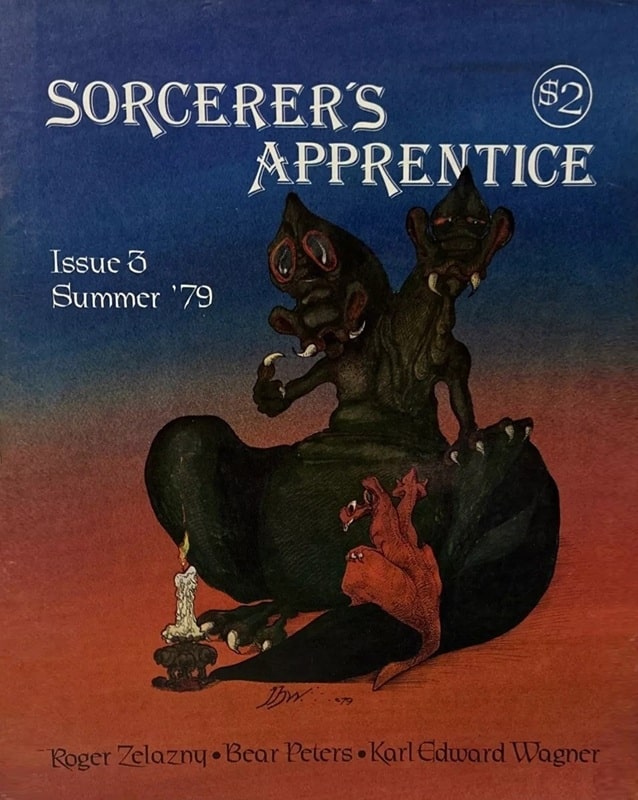 Sorcerer’s Apprentice, Summer 1979, edited by Ken St. Andre, containing “Garden of Blood.” Cover by Joan Hanke-Woods
10. “Garden of Blood” (1979)
Sorcerer’s Apprentice, Summer 1979, edited by Ken St. Andre, containing “Garden of Blood.” Cover by Joan Hanke-Woods
10. “Garden of Blood” (1979)
We again find Dilvish wandering through strange lands alone (except for his faithful Black). (According to the first paragraph, he’s working as a scout for a caravan, but we never see the caravan and it doesn’t affect the course of the story much, if at all.)
The lands are strange to us, but not to him. He’s been over this ground before, before he was trapped for 200 years in hell. He finds himself in the ruins of a town he once knew, named Trelgi. He and Black pass onward to a fair field full of bright flowers, where the town’s ancient stone altar still stands.
Through some combination of magic and narcotics from the flowers (flashback to the poppy scene in The Wizard of Oz), Black is paralyzed and Dilvish finds himself trapped in a dream or vision where he and Black (in human form) fight against the robbers who sacked Trelgi and slew its inhabitants.
A solid adventure-fantasy, well worth reading.
11. “Dilvish the Damned” (1982)Originally published in Dilvish, the Damned.
The last two Dilvish stories (apart from the novel) have something in common that distinguishes them from the others. We find Dilvish working for a living. He may be a somewhat sorcerous person who rides a demonic metal steed, but he apparently can’t pull gold coins out of Black’s ears, or other orifices. I like this, as supplying the grit that s&s needs (Joe McCullough’s great definition of sword-and-sorcery is “Fantasy with dirt.”) But it does put the end of this series on a different, more mundane level than its dreamlike, allusive beginnings.
After getting paid and buying supplies, he sets off for a castle called Timeless:
The blind poet and seer, Olgric, had told him that he would find there the thing that he sought.
But before Dilvish gets there, a guy on the road tries to rob him. The robber is pretty inept, and Dilvish in the end is inclined to let him go, but he tries to impale himself on Dilvish’s sword. It turns out that he’s been trying to get Dilvish to kill him. Dilvish is intrigued and, in spite of Black’s warnings, he stops to get the thief’s story.
The thief is named Fly and he is the walking definition of the phrase “mealy mouthed.” (He keeps saying things like “Well, yes and no.”) Dilvish eventually gets his story: he stole a magic belt from a god’s temple; now the adherents of the god are after him, as well as the adherents of a rival god who want the belt for their own purposes.
There’s some wiliness and chasing and fighting and a curse or two but, in the end, Dilvish returns the belt to the god from whom it was stolen, and he and his demonic steed get the hell out of there.
After the story proper, there’s a short coda. The next day, Dilvish is confronted by a young woman who begs for his help. Black warns him not to be taken in, and we’ve actually seen Dilvish tricked this way before (“A Knight for Merytha”).
But Dilvish can’t bring himself to deny a plea for help. ” ‘Damned if you do, damned if you don’t,’ he said, dismounting.” Which is at least kind of an amusing punchline to the series, if not laugh-out-loud funny.
 The Bells of Shoredan (Underwood Miller, May 1979). Cover by Matt Gouig
Overview
The Bells of Shoredan (Underwood Miller, May 1979). Cover by Matt Gouig
Overview
The parts of the Dilvish series are greater than the whole. Some stories, I would argue, are essential reading for the heroic fantasy enthusiast (e.g. “Passage to Dilfar”, “The Bells of Shoredan”, “Devil and the Dancer”). Most of the rest are well worth reading (e.g. “The Places of Aache”, or “Garden of Blood”). The weakest and longest story in this series (setting apart The Changing Land for another time) is “Tower of Ice”, and even it has some interesting stuff in it.
But it has nothing that connects it all together. It’s a set of fragments. Zelazny would have it that Dilvish is a man obsessed. He calls him “a humorless monomaniac.” (This from a letter to Carl Yoke, quoted in the afterword to the last Dilvish short story in the NESFA collection Nine Black Doves.) But Dilvish has at least two sets of concerns in the stories: defending Dilfar and other cities of “the East” from Lylish, the Colonel of the West, and also getting revenge on Jelerak, neither of which seem to me to be crazy. And most of the stories don’t involve either one of these goals, or mention them only in passing, undermining any picture of Dilvish as obsessive.
Zelazny knows his character better than anyone else does, obviously, but my point is that he doesn’t create the portrait of a monomaniac in the Dilvish stories that he actually wrote and published. There isn’t that much coherence in them. When Dilvish raises a ghost legion to fight for him in Shoredan, the actual fight he raises them for occurs offstage and is mentioned only in passing. Lylish and Jelerak are supposed to be these big menaces, but Lylish never appears onstage, and Jelerak only occasionally and somewhat unimpressively. Zelazny is careful to introduce us to a sorcerer named Strodd in “A City Divided” and make him indebted to Dilvish… but he’s only mentioned once in passing, later on, and he never appears in a Dilvish story again.
The good stuff in the stories is mostly the incidental stuff along the way. There is no overarching plotline that connects them, any more than there is for Leiber’s stories of Fafhrd and the Gray Mouser or REH’s Conan stories.
And that’s a virtue, not a vice. Zelazny’s great gift as a writer was for brilliant improvisation. These stories would be better if they were presented as a series of fragments from a heroic life, without any pretense of telling a continuous story.
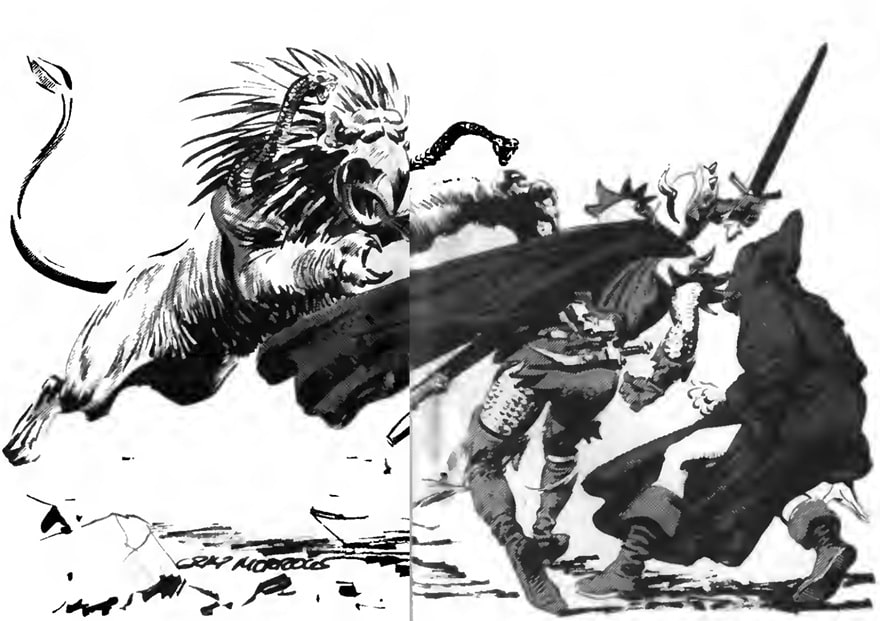 Interior art for “The Bells of Shoredan” by Gray Morrow. From Fantastic Stories, March 1966
Interior art for “The Bells of Shoredan” by Gray Morrow. From Fantastic Stories, March 1966
That was Howard’s idea for the Conan series:
“The average adventurer, telling tales of a wild life at random, seldom follows any ordered plan, but narrates episodes widely separated by space and years as they occur to him.” (From a letter REH wrote in 1936 to P.S. Miller, included in the Lancer/Ace Conan, p.17.)
I’m not saying every s&s writer has to imitate REH forever, but this approach would work better with the Dilvish stories than the pseudo-biography that Zelazny tries to force them into.
The reader who has read this far without dying of boredom deserves some kind of ringing peroration to send them rushing out into the street in search of trouble and fantastic adventure. Unfortunately I don’t have one.
I do have kind of a technical writing observation that, if nothing else, will help you to drift off to sleep in the friendly light from whatever device you’re reading this on.
In most of the Dilvish stories, we get almost nothing of Dilvish’s inner life. We have to deduce what he’s thinking and feeling from his words and actions — the same way we do with the people around us. This is unlike a lot of modern fiction, where we typically get the inner monologue of the viewpoint character. In lots of ways, Dilvish is not our viewpoint character; he is a character we are viewing.
That appeals to me because it’s more like ancient and medieval literature, and it gives him a degree of mystery. The later stories in the series where we get more of Dilvish’s feelings are part of that descent into mundanity, like the mentions of him working for a living. I don’t think that’s bad; it’s just interesting how Zelazny’s approach to the character changed over the nearly-two-decades that he wrote about him.
Now go ye forth into the mysterious vale of night and smite those who must be smitten, even as your heart doth compel ye. (Unless that seems inadvisable for ethical, legal, or practical reasons. Offer void where prohibited.)
Our previous coverage of Dilvish at Black Gate includes:
Dilvish, the Damned by Fletcher Vredenburgh (September 12, 2017)
This article originally appeared at James Enge’s excellent Engeblog on January 23, 2025.
OUT NOW – Fantastic Schools War
Featuring a whole new Schooled in Magic novella!
Have you ever wanted to go to magic school? To cast spells and brew potions and fly on broomsticks and – perhaps – battle threats both common and supernatural? Come with us into worlds of magic, where students become magicians and teachers do everything in their power to ensure the kids survive long enough to graduate. Welcome to … Fantastic Schools.
Meet the students preparing for magical war, learning how to wield sorcerous weapons or fantastic talents in defence of the world; meet the magicians testing their abilities in worlds touched by the fantastic and the supernatural, or the magicians completing their final exams – or going to war, learning on the job as the darkness moves ever-closer to home. Meet the students who think they have all the time in the world, and the ones who discover that their training has suddenly become all too real.
The glory of war awaits them, in these pages, but so too does the price …
Purchase from: Amazon US, Amazon UK, Amazon CAN, Amazon AU.
And check out the latest call for submissions here!

Republished: The Decline and Fall of the Galactic Empire
The Federation has endured for hundreds of years, but as corruption and decadence wear away the core of human unity, rogue admirals rise in rebellion. As the Federation struggles for survival, two officers, an old Admiral and a newly-minted Lieutenant, may be all that stands between the Federation and destruction.
Book One: Barbarians At The Gates (now on KU)
DOGE- Supernatural Division (episode 6)
The Candle Is Lit…
A few days ago, when the edits for This Kingdom Will Not Kill Me just landed in our inboxes, I made this candle with the idea that once this, final content edit was done, I would ceremoniously light it.

In all fairness, the candle looked prettier in my head, but I don’t normally make candles.
Well, guess what?

That’s right, the edits are done.

Here is the candle, burning in the study. Hopefully it will smell lovely.
The edit has been sent off and I’m going to take a couple of days to recover.
The post The Candle Is Lit… first appeared on ILONA ANDREWS.
Comment on A Beginner’s Guide to Drucraft #31: Sigl Recycling (I) by Skeeve
Interesting, how does the technology to ‘drain the well’ (and store it for later use) interact with sigil recyling?
Looks like one could ‘create their own wells’ by acquiring different sigils and capturing the essentia from them. With enough skills, research (of background of these sigils) and money, one could actually build quite a formidable well this way.
There, Wolves: Part III
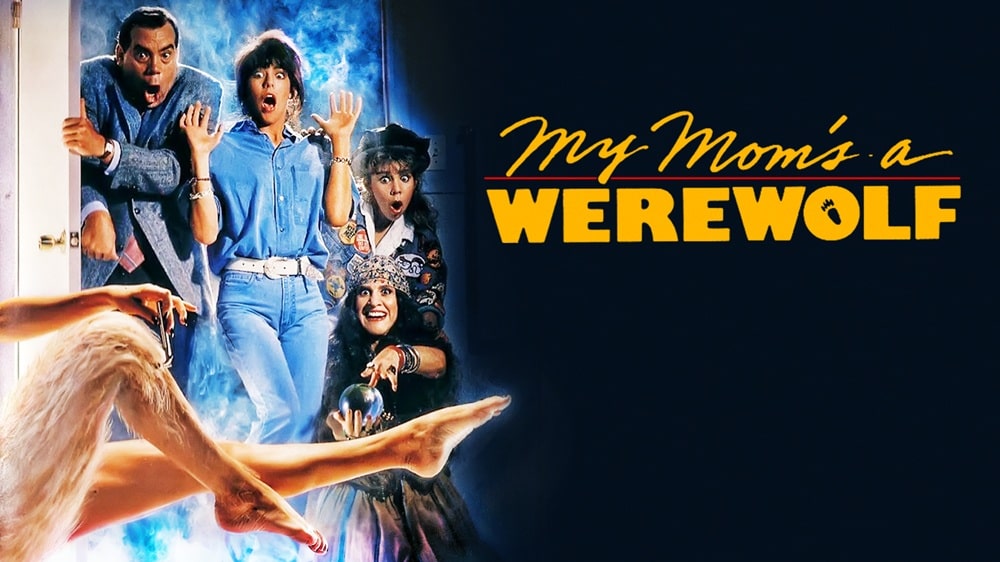 My Mom’s a Werewolf (Crown International Pictures, May 12, 1989)
My Mom’s a Werewolf (Crown International Pictures, May 12, 1989)
A 20 film marathon of werewolf movies I’ve never seen before.
As usual, the films must be free to stream.
I’ve got a bad feeling about this.
My Mom’s a Werewolf (1989) YouTubeMan or beast? Gradual, hairy transformation into rubbish suits.
Howlin’ good time? The 80s are arguably the greatest decade for horror and, perhaps, the much maligned sub-genre of horror comedy, but this one squeaks in at the end hoping to ride some Teen-Wolf coat tails, and it doesn’t quite succeed. The intention is there, everyone gives it their all to a cartoonish level, and John Saxon is awesome, but for me the jokes didn’t always land, and it felt horribly dated.
The film has a similar premise to the OG Fright Night (teen recruits monster nerd friend to combat monster and save family), but it was all a bit too cutesy for my tastes and, despite the promise of a great werewolf at the end, the actual makeups were a bit of a let down. Fun to see Ruth Buzzi again though, looking younger than she did in the 60s.
5/10
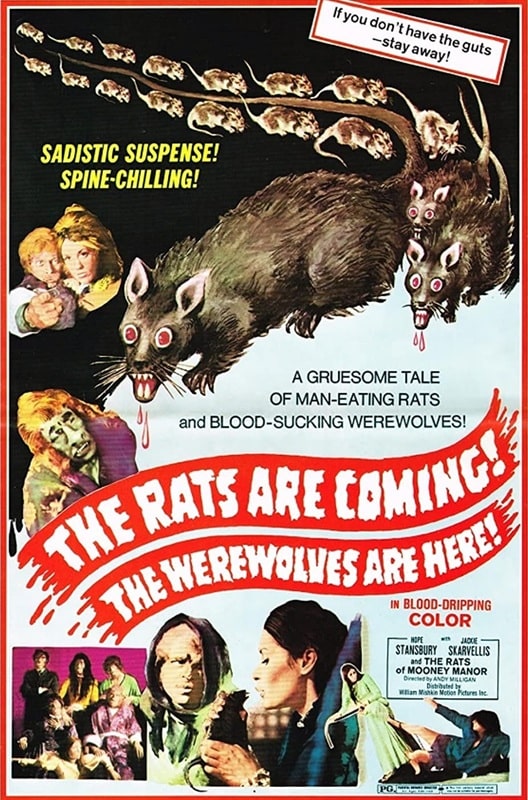
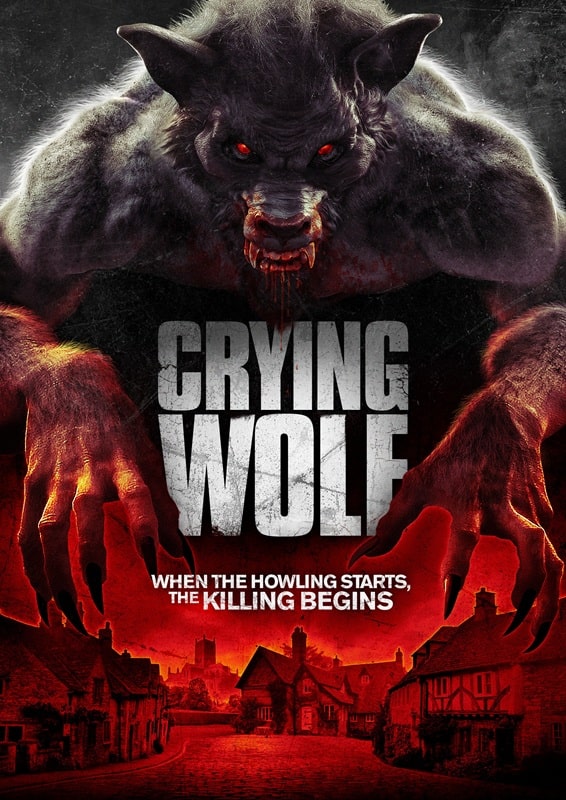
The Rats Are Coming! The Werewolves Are Here! (William Mishkin Motion
Pictures, May 1972) and Crying Wolf (Uncork’d Entertainment, 2015)
Man or beast? Brownface + hairy eyebrow makeups.
Howlin’ good time? This is a film from the notably sleazy mind of Andy Milligan, who once enjoyed stuffing his grindhouse efforts full of sadism and salaciousness. This film, however, is his tamest by far, with nary a whiff of sex or violence (although he does include a ghastly bit of sadistic treatment towards a live mouse, which is unpleasant).
The best thing about this movie is the title, but even the rats are merely a ten-minute distraction, presumably an after-thought, during this dull exercise in miserable family members sitting around moaning about being werewolves. The actual beasts appear at the end, when everyone seemingly turns into one and set upon each other for no good reason. Pretty awful.
3/10
Crying Wolf (2015) TubiMan or beast? CG/gorilla suit hybrids.
Howlin’ good time? Full transparency, I put this one on because Caroline Munro headlines it, but when she disappears after 5 mins, I should have done the same.
This is such an odd film, but not in the charmingly odd sense. Allegedly a comedy, it’s as cutting edge as a Benny Hill sketch but with none of the subtlety, complete with head turn ‘whooshes’ and slide whistles. The thin-as-tissue plot is padded out with flashbacks, and flashbacks within flashbacks, none of which bring anything to the story.
There a couple of fun gore effects, but it’s hampered by some lousy CG and awful werewolf costumes, and the whole affair has been re-dubbed using some lacklustre ADR and one awful American accent. The whole hot mess is narrated by a detective in a pub, and it comes off as a prolonged episode of Garth Merenghi’s Dark Place, but with worse production quality. Terrible.
3/10
 Strippers vs Werewolves (Well Go, April 27, 2012)
Strippers vs Werewolves (2012) Prime
Strippers vs Werewolves (Well Go, April 27, 2012)
Strippers vs Werewolves (2012) Prime
Man or beast? Hairy, humanoid, beast-faced bad boys.
Howlin’ good time? I went into this one expecting the usual crap (having seen Zombies vs Strippers in a moment of weakness a couple of years ago), but was a little surprised by how much I liked it. Don’t get me wrong, it’s still rubbish, released the same year as the superior (but still rubbish) Cockneys vs Zombies, but clearly everyone was having a splendid time, and there were a couple of gags that managed to get a laugh out of me.
It’s a UK production through and through, taking place in Basildon (and finishing in Dagenham!) and full of your stereotypical Essex-types, but I wasn’t ready for the cameos from folks in need of new patios, including Steven Berkoff, Robert England, Martin Kemp, Lysette Anthony and Sarah Douglas (who was the best part of the film). It’s rude, slightly violent and full of knockers, which is to be expected, daft as a brush, but still more fun than many of the films I’ve watched during this project and I didn’t hate the werewolf designs.
Recommended for people who like Alan ‘Brick Top’ Ford and bosoms.
6/10
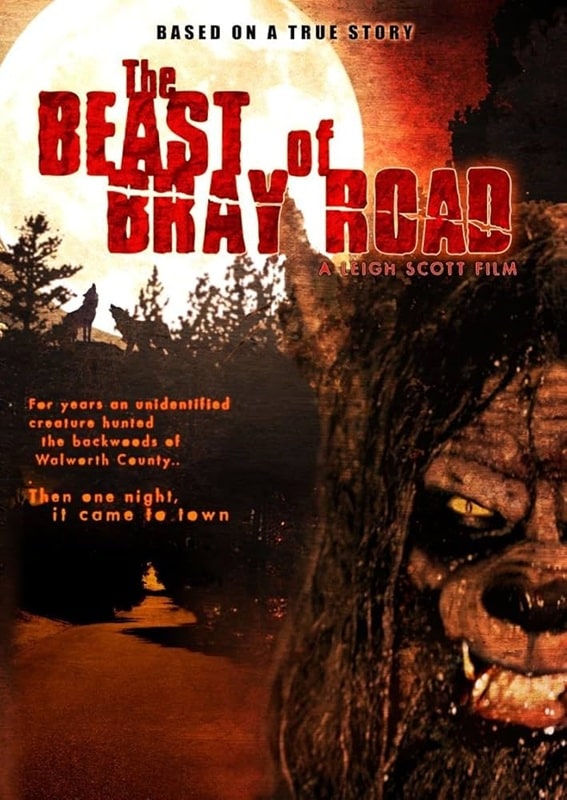 The Beast of Bray Road (The Asylum, September 1, 2005)
The Beast of Bray Road (2005) YouTube
The Beast of Bray Road (The Asylum, September 1, 2005)
The Beast of Bray Road (2005) YouTube
Man or beast? Hairy, humanoid, naughty thing.
Howlin’ good time? It’s an Asylum flick, but don’t let that put you off. Granted, it’s the usual fare; two-dimensional charac… sorry… cannon fodder going through the motions, hitting their marks and spouting uninspiring dialogue. However, a great portion of the budget went on practical effects, including more loops of guts than a back-alley sausage shop. The gore was over the top and fun, the beast however was a bit of a laugh. In fact, this poster doesn’t do the film any favours, and I can’t believe they didn’t hire an artist to paint a kick-ass werewolf for it.
As it is, this one just reminded me of Zeb from Star Wars: Rebels (if you know, you know), and I couldn’t take it seriously. Ultimately though, it’s a better-than-most Asylum effort, and I was entertained, so… congrats?
6/10
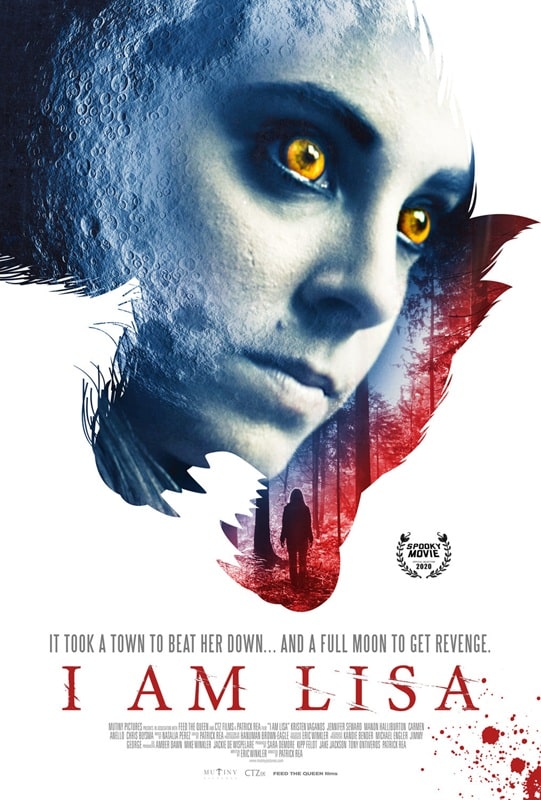
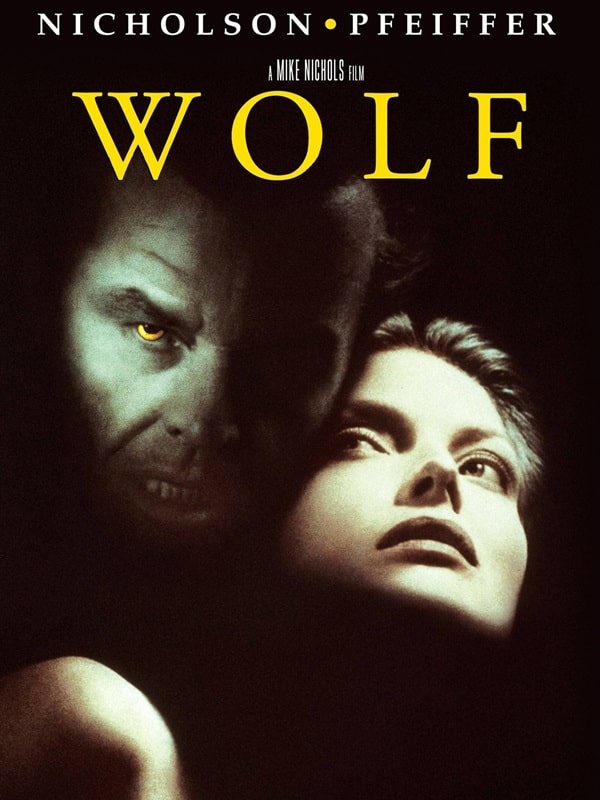
I Am Lisa (Mutiny Pictures, July 2, 2020)
and Wolf (Columbia Pictures, June 17, 1994)
Man or beast? Subtle lady beast.
Howlin’ good time? I’m glad I saved this one until close to the end of my werewolf watch-a-thon, because I was quite impressed with this indie film, shot on a low budget but spending the money wisely. It’s a tale of abuse and revenge, with strong female leads, well-written queer undertones and some lovely cinematography. I thought the director Patrick Rea handled the story really well and the score had a nice throwback vibe to it. In fact, the whole shebang put me in mind of I Spit on your Grave, with more teeth.
My only gripes lay with the sound design and the fight choreography, neither of which packed enough punch and let down the climax, but overall it’s a solid watch and I’m going to go ahead and recommend it.
8/10
Wolf (1994) PrimeMan or beast? Nicholson and Spader being hairy.
Howlin’ good time? Saved a ‘proper’ film for last, because it would be nice to go out with a bit of quality, and I hadn’t seen this before. However, I was wholly unprepared for how ludicrous and dull it actually is.
At the risk of invoking the wrath of those of you who fondly* remember this as being great, let me just express my surprise over so much before and behind the camera talent coming up with this wereturkey. It features amazing actors, Mike (The Graduate) Nichols directing, FX from Rick (American Werewolf in London) Baker and a score by Ennio (Ennio freakin’ Morricone) Morricone, and yet it is still as dumb as a bag of wolf nards. The lycanthropic plot is reduced to a subplot as the main focus is about a guy getting his job back, and its direction is a bit aimless (unlike Jack’s pee).
Is it a satire? Not funny enough. Is it horror? It’s got less teeth than grandma shark. Gah — maybe at this point, now finished with the werewolf movies, I’m jaded, cynical and ready to move on — but I really was expecting better.
6/10
*incorrectly
Previous Murkey Movie surveys from Neil Baker include:
There, Wolves: Part I
There, Wolves: Part II
What a Croc
Prehistrionics
Jumping the Shark
Alien Overlords
Biggus Footus
I Like Big Bugs and I Cannot Lie
The Weird, Weird West
Warrior Women Watch-a-thon
Neil Baker’s last article for us was There, Wolves: Part II. Neil spends his days watching dodgy movies, most of them terrible, in the hope that you might be inspired to watch them too. He is often asked why he doesn’t watch ‘proper’ films, and he honestly doesn’t have a good answer. He is an author, illustrator, outdoor educator and owner of April Moon Books (AprilMoonBooks.com).
Love is in the Air | 9 Steamy Romance Novels to Devour
Okay, romance novel lovers, cuddle up with your warm blanket in your favorite reading spot.…
The post Love is in the Air | 9 Steamy Romance Novels to Devour appeared first on LitStack.
Some Thoughts On The Current European/American Situation
Some Thoughts On The Current European/American Situation
“Closing your eyes isn’t going to change anything. Nothing’s going to disappear just because you can’t see what’s going on. In fact, things will even be worse the next time you open your eyes. That’s the kind of world we live in. Keep your eyes wide open. Only a coward closes his eyes. Closing your eyes and plugging up your ears won’t make time stand still.”
― Haruki Murakami, Kafka on the Shore
Well, we can’t say we weren’t warned.
It was easy to believe, after the end of the Cold War, that Russia was a broken state and would remain so for the foreseeable future. This was obviously inaccurate. There was no danger in both expanding NATO and cutting European military forces to the bone, Europeans thought, nor was there any risk in becoming dangerously dependent on Russian gas and oil. The prospect of Russia being able to rejuvenate herself, as Germany had done after 1918, seemed increasingly remote. The chaos and corruption of the Yeltsin years left a lasting impression. Unfortunately, that impression was severely misplaced.
Since assuming power, Vladimir Putin has pursued a cold-blooded strategy of rebuilding military power, reassuming Russian primacy amongst the surrounding states and generally making it clear that Russia is no longer a military pygmy whose opinions can be safely ignored. To his credit, Putin played a weak hand very well. Russia crushed Chechnya, at appalling cost; Russia Georgia (the country, not the state) firmly in her place, Russia took over and annexed a chunk of Ukraine, Russia deployed a major force to Syria to support their allies in the region (a feat only matched by Britain and America in recent years), all the while manipulating the global economy to ensure that international opposition was limited and largely futile. All of this should have been a wake-up call.
Putin does appear to have believed, to some extent, in his own propaganda. The Russians appear to have developed an overinflated idea of their military prowess, and seriously believed that they could launch a blitzkrieg into Ukraine, capture the capital, and declare victory before any sort of international opposition could possibly be mobilised. In this, they were wrong. Far from being a three-day policing operation, or however else the Russians chose to spin it, the Ukraine war has bogged down into a conflict dangerously reminiscent of the First World War. Russian gains, such as they are, have come at appalling cost. Worse, for Russia, the fact that their military has been exposed as far less powerful and capable as everyone believed means that their neighbours and more distant opponents are more willing to risk conflict with Russia by supporting Ukraine. It was possible to believe that Russia would lose, quickly and badly, and the disaster would lead to Putin accidentally brutally shooting himself in the back several times.
I was not comfortable with that prediction. In 1939, for example, Russia invaded Finland. The initial invasion was a disaster, with the Finns brutally humiliating Russians time and time again. Their valour disguised the fact that Russia was far stronger, numerically speaking, and the natural selection of an ongoing war ensure that Russia would learn from her own mistakes, adjust her tactics, and resume the offensive. Finland did manage to convince Stalin that she was too tough a morsel to swallow, a remarkable feat given that Stalin was far more ruthless than even Putin, but she was effectively beaten. It could have been far worse.
The Winter War gave British, French, and German politicians a seriously understated impression of Russian military power. The British and French, desperate for a way to help Finland, came up with crazy plans to bomb Russian oil fields, convinced the Russians would not be able to retaliate in any substantial way. Hitler, at the same time, became equally convinced that Russia was a paper tiger, that the might of Nazi Germany could defeat the Russians in no more than six weeks (a delusion shared by some in Britain, who held out no hope of Moscow surviving German attack). This was a serious misjudgement. The Russians survived Operation Barbarossa, defeated the Germans soundly, and marched on to conquer Berlin. We all think twice about offending the mighty Russian bear because Russia held half of Europe in a grip of steel for nearly 50 years.
Or we did.
European politicians appear to have pursued a frankly bizarre policy towards the Ukraine War. On one hand, it is greatly to the credit of many politicians that they have offered Ukraine vast amounts of financial, military, and other material support. There is very little sympathy for Russia in Europe, nor should there be. On the other hand, they have refused to grapple with the implications of the Ukraine War, or to consider the very dangerous possibility that Russia will actually win the war, or at least come out ahead. There is both a firm belief that Russia can and must lose in Ukraine and yet, at the same time, there is a dangerous complacency lulling Europe to sleep even as the Russians finally start making some battlefield gains.
The blunt truth is that Europe has cut its military forces to the bone. Europe’s ability to project power outside its own borders is very limited. Europe’s ability to resupply its troops and replace ammunition expended in wartime (usage rates are always higher than predicted) is even more so. European deindustrialisation makes it hard to rebuild, let alone expand what little remains to Europeans. Protected by the United States, European politicians have indulged in fantasies of abolishing nuclear power, moving all those dirty industries to the Third World, and that soft power can make up for a lack of hard power. This did not work out well for Greece, when she was confronted by an expanding Imperial Rome, and it will not work out well for Europe. The key to preventing war is to be ready for it, and Europe is not ready.
How many wake-up calls do we need? Must we wait until the call starts coming from inside the house?
The rot goes deeper. Faith in governments is at an all-time low. Social cohesion is coming apart at the seams, the problem of mass migration and government unwillingness to deal with it firmly and decisively empowering more radical political parties; government censorship and two-tiered justice is undermining confidence in government, the media, and nearly everything else. It is difficult to believe that many Europeans will willingly fight for countries that appear to have turned their backs on the native population, and punish them for daring to complain. I think is fairly safe to say that patriotism is on the decline too, or that it is benefiting the more radical parties rather than centrists. But then, if reasonable voices refuse to acknowledge a problem and deal with it, unreasonable voices will take advantage of the problem to promote themselves.
It is difficult to believe, too, that conscription will ever be reintroduced in Europe. It would be extremely unpopular. Like I said, very few people want to fight for the current order. But even if it is introduced, how will Europe arm those soldiers? It is incredibly difficult to produce modern weapons, from main battle tanks and fighter jets to man-portable antitank and anti-aircraft missiles, without a major industrial base. The problem will not be solved by recruiting vast numbers of soldiers, willing or not. Those soldiers need to be armed, and that means Europe must build up its industrial base too.
But this too is a problem European politicians have chosen to ignore.
This leads neatly to a second problem.
There has always been a strong isolationist streak in the United States of America. It is easy for European politicians to forget this, because every president from FDR onwards has been an internationalist (including Trump, to some extent). America has hugely benefited from being the world’s policeman, but not unlike the European Union the benefits of this policy have not been spread evenly. A sense has been growing in American thought that argues, not unreasonably, that Europe should pay more towards her own defence, and build up her own military forces to the point they can serve as more than a tripwire. During the Cold War, the Europeans could be relied upon to give a good account of themselves. Now, it isn’t so clear they could. It may not be entirely fair to say that the Europeans are wholly dependent on America, but there is a great deal of truth in it.
It is difficult to understate how offended and hurt many Americans were by European reluctance to provide major support after 9/11. It is easy to make fun of people who renamed ‘French Fries’ as ‘Freedom Fries,’ or insist on pronouncing “European” as “Your-A-Peon,” but such humour masks a more serious reality. The political consensus that America could and should bolster European defence was severely weakened, with Americans openly questioning the value of NATO to the United States. Why should the United States send its young men and women to defend nations that were not only unwilling to defend themselves, but spent much of their time criticising the United States and/or take advantage of America to undercut its economy? This is not a new thing – similar concerns were raised about Japan, although those faded away after the Japanese crash – but the world is now a very different place. The American failures in Iraq and Afghanistan have given the isolationists good reason to think twice about foreign entanglements. What does the United States get out of them, except body bags?
You may be reading this and thinking that that is a stupid argument. You might be right. But others disagree.
Every American President since Clinton has tried to nudge Europe to spend more money on its own defence. Bush43 tried. Obama tried. Trump tried. Biden tried, and his arguments were backed up by a full-scale war exploding in Europe’s backyard. The response was always the same, more military cuts. It is a simple fact of life that people grow tired of giving, no matter how good the cause, and America was slowly falling out of love with NATO. To help someone get back on their feet after being knocked down is one thing – in fact, it is the core of right-wing charity – but to keep supporting them the rest of eternity is quite another. American Internationalists are slowly being superseded by American Isolationists, who are deeply suspicious of international involvements and have no particular interest in writing blank cheques.
It is easy to blame the current crisis on Donald Trump and JD Vance. Vance certainly fits into the American Isolationist tradition far more than Donald Trump. In Trump’s case, matters are made worse by the fact he genuinely did point out the dangers of becoming dependent on Russian oil and gas (as well as being one of the first presidents to send large arms shipments to Ukraine), and response he got from Europeans was largely mockery and casual dismissal. A stronger and more mature man than Donald Trump would find this very hard to take, and in Trump’s case he would have the grim awareness that he had been right all along and his detractors were not. (European governments supporting Kamala Harris in the 2024 election are another display of European complacency, a foolish move no matter what you think of Donald Trump and/or his chances of victory in 2024.) The combination of European complacency, refusal to believe that history has restarted (in truth, it never stopped), and head-in-the-sand thinking has produced a very dangerous situation, in which Europe is exposed to enemy attack while at the same time alienating the one hope of a conventional defence.
Let me be very clear on one point. Putin and Russia are in the wrong. The Russian justifications for the war make sense from a geopolitical point of view, but they do not justify a full-scale invasion and conquest of Ukraine. Might does not make right. But as anyone who has dealt with a schoolyard bully knows, the only way to stop him is to give him a bloody nose and the only way to do that is to prepare for conflict. We now have a situation where Ukraine cannot continue the war for much longer, cannot recover her territories through her own efforts (no matter how many weapons we send them), and we are unable as well as unwilling to send our own troops to drive the Russians out. It is possible, true, that Russia’s economy will collapse, or that some kindly soul will assassinate Putin, take power, and order a withdrawal. The former is unpredictable. The latter, as pleasant as it sounds, will mean that Putin’s successor (assuming he manages to take power without a fight, which isn’t guaranteed) will face the same dilemma currently challenging Vladimir Putin. If Russia gains nothing for her efforts, it will be fatal for her leader. Any successor will look at the example of 1918, where the German civilian government found itself forced to accept an extremely unpopular peace, and think twice about making any agreement that will look like a defeat, let alone a surrender.
In Europe, politics are genteel. In Russia, they can be lethal.
The blunt truth is that European politicians are no longer serious men. They have grown so used to the American umbrella that they have surrendered the tools they need to shape the world, even in their own backyard. Faced with a slowly shifting situation, a growing split between America and Europe, they have chosen to ignore the problem rather than take steps to address it. Faced with an outright war, they have made grandiose statements without taking measures to prepare for an expansion of the conflict. They have been long on words, and short on action. And in doing so, they have made the world a much more dangerous place.
In recent days, many commenters have raised the spectre of Munich. That is unfair. Neville Chamberlain was a fool who believed the Nazis were overwhelmingly powerful (they weren’t), that any war in 1938 would be long and bloody (probably incorrectly), and the cost of the war would doom the already fragile British Empire (probably true). If Chamberlain had stood up to Hitler at Munich, the world would be a very different place and much of the slaughter of the next six years would have been averted. But Chamberlain believed he was buying time to rearm, to catch up with the Germans and prepare for a war. He may have severely misjudged German military power, but he was laying the groundwork to defeat it. The same cannot be said for modern-day European politicians. They have created a situation in which they are playing poker with neither cards nor stake against an opponent who understands the realities of power in a way they cannot match.
Stalin famously asked how many divisions the Pope had. Putin could easily ask the same about European politicians who have no conception of how weak they have become, or that the wake up calls they have heard over the last two decades have become the howl of the approaching wolf.
We need a change. And fast.
THE SHADOW OF THE TORTURER by Gene Wolfe
Two Howards Fathering Sword and Sorcery – Swords Together!
Left: The memorial booklet for Howard Andrew Jones given to attendees at the February
22nd Celebration of Life. Right: Sean CW Korsgaard gives his eulogy for Howard.
Foreground: Christopher Rowe, Cinda Hocking, John C. Hocking. Photo by John O’Neill
A Celebration of Life for Howard Andrew Jones (HAJ) was just held in Evansville, IN, Feb 22, 2025. The event gathered friends, family, and over a dozen author colleagues. Numerous online memorials and tributes had been posted leading up to this. Links to many are listed at the bottom of the post; reading these reveals wonderful insights. This article aims to honor HAJ slightly differently by echoing excerpts from his blogs intermixed with remembrances and emphasizing the importance of community.
It struck me that when discussing HAJ, there are always references to REH (Robert E. Howard, indisputable “Father of Sword & Sorcery Genre”). Whereas REH kicked off the genre with his heroes in the 1920-30s (Conan, Bran Mak Morn, Kull, etc.), a hundred years later, the other Howard, our dear HAJ, championed S&S, wrote S&S, and built a community of S&S readers & writers.
You may already know that HAJ edited the online Flashing Swords ezine (links to internet archives below), grew Black Gate in print and online, edited the Harold Lamb series, led the Tales from the Magician’s Skull Magazine, and wrote copious amounts of pulp and fantasy fiction (Asim & Dabir, Ringsworn, Pathfinder, Hanuvar). He did all that while immersing himself with authors and readers.
A lifetime of activity is impossible to capture, but several montages of his writer-focused activities were captured and shared at the celebration (PDF link); and Sean CW Korsgaard created a spectacular video playlist of HAJ interviews, panels, and more.
We’ve been conditioned to believe that there aren’t any real heroes and that everyone’s in it for themselves; we’ve been trained to be skeptical and ironic and detached and sarcastic and hip. Yet even as we sneer and laugh with our friends, we know it’s a lie. — HAJ 2008Herein, you’ll learn his thoughts behind the “New Edge” S&S term he coined, how he inspired the Goodreads S&S group, how he conjured up the Day of Might, and more! HAJ was a mentor and coach to many dozens and a father figure to some (as Hanuvar champion and Bean editor Sean CW Korsgaard attested in his remembrance, image above).
I suspect HAJ would balk at being called “The only father of all S&S communities.” Heck, being called a simple role model made him uncomfortable (sorry, Howard). But his community building and influence are undeniable. They deserve to be called out and remembered. Funny enough, Howard called “Harold Lamb the grandfather of S&S” (evidence herein). With REH being the father, maybe that makes HAJ the grandson?!
Whatever. Read on, mortal dogs, and imbibe the contagious sorcery of a hero recently passed. Hear now his closing line for his editorials, which resonates with comradery:
Swords Together!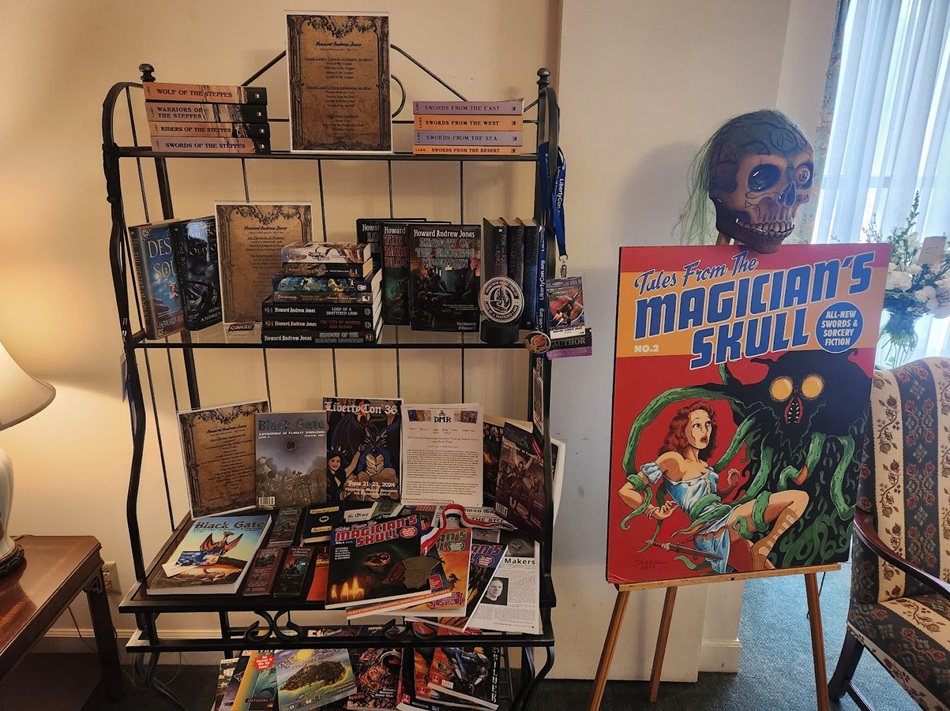 The Writing Display of Howard Andrew Jones at his Celebration of Life, February 22, 2025
Goodreads Sword & Sorcery Group
The Writing Display of Howard Andrew Jones at his Celebration of Life, February 22, 2025
Goodreads Sword & Sorcery Group
The Goodreads S&S Group began in 2012, initiated by Periklis Begzos. We struck a friendship, and I became a lead moderator for 10 years before getting pulled into organizing the Gen Con Writers Symposium over the Covid era (not ironically, a role that followed after HAJ encouraged me to volunteer for the convention). Anyway, S&S GR group still exists, but activity has waned. Regardless, I share a moving anecdote from Periklis that captures how Howard helped others and they helped him:
“Regarding Howard’s touch, I remember discovering his book “The Desert of Souls” in early 2012. I loved it. I was following Black Gate magazine and what struck me the most was the love for the culture (of both S&S and adventure/pulp fiction) that Howard spread. At the same time he announced a competition for naming the Dabir & Asim series. I submitted the name “The Chronicles of Sword and Sand” and was awestruck when it won. Along came a gift pack of all of Howard’s published works, with a printed map and a lovely letter from him. It really pulled me from a dark place I was going around that time and allowed me to start the public Goodreads group about sword and sorcery. So I would think that Howard’s generosity of character and his altruistic involvement with all things Sword & Sorcery are keeping inspired to this day.” Periklis Begzos
Harold Lamb is the ‘Grandfather of S&S’?Perusing HAJ’s comments in the Goodreads Sword and Sorcery Group, I came across this gem that showcases his love for Lamb and S&S.
I stumbled across one of his Cossack collections when I was in high school and was immediately reminded of one of the Leiber collections of Fafhrd and Mouser stories. Not because Khlit the Cossack is a thief and bravo, because he isn’t, but because both Lamb and Leiber wrote serial stories with continuing characters — almost like a TV series — stuffed full of action and adventure and sense of wonder.
I’ve argued at length, in many places, that Lamb is the unsung grandfather of sword-and-sorcery, because he’s got nearly EVERYTHING except the imaginary world and real sorcery. He occasionally (very occasionally) suggests the fantastic. And he is one of the very first to write adventure fiction with a mostly modern feel. He’s still compulsively readable today. Combine that with his laconic style and pacing and sense of adventure — not to mention surprise — and you have something phenomenal.
I was astonished when I discovered how many of his stories that had not been collected were excellent. His work isn’t like, say an obscure rock band that’s only good when you listen to their greatest hits. Even many of his deep album tracks are strong. I dreamed that one day I could find them all and read them. Slowly I did. And because the only job I could find in the economic downturn of the ’90s was as a third shift proofreader, I ended up becoming an editor, which made it possible for me to cold call Bison Books and pitch the collections. I knew how to talk “book” in the language of “editor” and I’d amassed a sizable collection of obscure Lamb texts by that point. Because I loved his stories I’d accidentally become an expert, and because of my accidental training I was perfectly positioned to make it happen. Serendipity. — HAJ 2016, Goodreads Threads
Magazine Editing and Honing A New EdgeIn 2005-2007, Howard edited the first six 6 e-zones of Flashing Swords (this link goes to the archived internet that offers the PDFs! Go get them!). How influential can an e-zine be? Read the introduction of Return of the Sword where esteemed heroic fiction champion Jason M Waltz lists Flashing Swords as one of his inspirations (and provided Jason an opportunity to become an assistant editor; Rogue Blades Entertainment and Foundation evolved from Jason’s own passion to build an S&S community).
In 2006, Howard moved along to take a position as Associate Editor at Black Gate. As John O’Neill mentions in his tribute and oral remembrance, Howard quickly rose from exuberant writer and associate editor to Black Gate’s first Managing Editor. HAJ grew the website driven by a passion to get fresh content posted daily and enlisted over thirty staff. In 2016 Black Gate Magazine was awarded a World Fantasy Award, a recognition that John O’Neill has said reflects Howard’s devotion (keep in mind, John is also a superb, understated mentor/hero who deflects compliments).
In 2008, as Managing Editor at Black Gate, HAJ posted his “manifesto” regarding a resurgence brewing in Sword & Sorcery fiction: Honing A New Edge Part 1 & Part 2 (these originally appeared in the introductory editorials Issue 3 & 4 as “The New Edge”). Excerpts are below. This sentiment resonated with many authors and editors, and a decade after its posting, directly inspired the creation of New Edge Sword & Sorcery Magazine (though editor Oliver Brackenbury has a slightly different definition than that of HAJ, read Oliver’s interview on BG for more). Incidentally, New Edge S&S 2025 has another crowdfunding running now, check out the link for the new Jirel of Joiry.
Traditional S&S Heroes (from Honing A New Edge Part 1)The protagonists in sword-and-sorcery fiction are most often thieves, mercenaries, or barbarians struggling not for worlds or kingdoms, but for their own gain or mere survival. They are rebels against authority, skeptical of civilization and its rulers and adherents. While the strengths and skills of sword-and-sorcery heroes are romanticized, their exploits take place on a very different stage from one where lovely princesses, dashing nobles, and prophesied saviors are cast as the leads. Sword-and-sorcery heroes face more immediate problems than those of questing kings. They are cousins of the lone gunslingers of American westerns and the wandering samurai of Japanese folklore, traveling through the wilderness to right wrongs or simply to earn food, shelter, and coin. Unknown or hazardous lands are an essential ingredient of the genre, and if its protagonists should chance upon inhabited lands, they are often strangers to either the culture or civilization itself. — HAJ 2008
Being Heroic (from Honing A New Edge Part 2 )We’ve been conditioned to believe that there aren’t any real heroes and that everyone’s in it for themselves; we’ve been trained to be skeptical and ironic and detached and sarcastic and hip. Yet even as we sneer and laugh with our friends, we know it’s a lie. Heroes really are out there. They’ve lived and breathed and sacrificed right here on this very Earth, and some of them are still at it. Students of history know them. Sometimes we can even find them covered by our local news stations. Stories of heroes, not of dejected mopers, have inspired us since the dawn of humanity, and we should not be embarrassed if they continue to fire our imagination. — HAJ 2008
HAJ: So what are those New Edge guiding principles? Briefly:-
A hardboiled tone — as in terse and unsentimental
-
Exotic settings and/or settings that live — as in NOT faux Tolkien (if the settings echo Tolkien or other writers then they must be twisted or seen from some new perspective)
-
Evoking a sense of wonder — magic is never banal or easy, the fantastic should not be mundane
-
High energy storytelling — as in fast and without padding
From a 2012 editorial post, we learn HAJ’s gratitude for being part of a community.
We wouldn’t be working so hard to get published in this genre if we didn’t love the genre, and I can trace a lot of my success back to actually becoming involved in it (I already posted about the exact steps to my book deal a year or two ago). Corresponding with other writers, writing reviews for genre sites, reading slush, writing editorials, editing for ‘zines and magazines. Eventually, a whole lot of people had heard of me, so that I wasn’t a complete unknown when it got to be time to try to promote my books.
I didn’t know that was going to happen — I just couldn’t stay away from fantasy fiction, particularly heroic fiction. But it DID happen, and even though every author’s journey is a little different, surely there’s some lessons from this story some of you out there could find useful. — HAJ 2012
When you begin your writing career, you’re joining a community — HAJWriting is a lonely business and I wanted to meet some kindred spirits. What I didn’t realize was that I was also forming a network of friends and allies, AKA “networking.” I dislike that word, though, because it suggests that one is cold-bloodedly setting forth to make friends to climb the ladder, probably before callously putting them aside for new and better and more powerful contacts as one advances. I realize now that I was becoming part of a writing community.
Many writers grow up thinking of the writing profession as a noble romantic one, where we sit alone in a tower room with our raven on a bust of Poe and a cat in our lap. Well, okay, I never pictured that, exactly, but I expected that I would write stuff and I just had to send it out until some editor finally printed me, probably sooner rather than later. As I became a regular at various magazines, I realized just how rewarding it was to be exchanging letters with editors and fellow authors and even readers from the various magazines. After I jumped the editorial fence, I started to comprehend that part of what you’re doing with a magazine is helping to build a community of writers and readers. — HAJ 2012
The Evil Skull versus the Heroic HanuvarIn 2017 (Kickstarter Link), Howard teamed with Joseph Goodman (Goodman Games) to create Tales from the Magizian’s Skull (as Joseph describes in his tribute).
Howard shared my appreciation of how fiction can inspire great gaming. We were both fans of several of the same things: D&D and DCC RPG, Appendix N, and Weird Tales, the publication that first published many of the Appendix N authors. We decided to start a fiction magazine together. From there we created Tales From The Magician’s Skull. The issues of that magazine that I published are among the Goodman Games publications of which I am most proud. Tales From The Magician’s Skull stands out from every other periodical in its category for its titular hero (or perhaps villain?), who would not exist were it not for the weird melding of Howard’s and my brains. Somehow our mutual creativity synthesized this bizarre character who seemed completely real to both of us. The Magician’s Skull was so integral to our mutual imaginations that we tag-teamed to write the editorials, articles, and memorandums attributed to the Skull. — JG 2025
The magazine moved ownership from Goodman Games to Outland in 2024 (here is their KS page for issues 13+ and their current store). The magazine’s run was a creative fusion of Howard and Joseph, but Howard was the frontman under the mask and editor. I shared my thoughts within the Science Fiction Writers of America (SFWA) obituary, and echo them here since they capture how Howard and the Skull persona complemented each other:
Howard’s Skull’s persona resonated since it was the antithesis of him. Whereas the villainous champion of the titular magazine spitefully called his readers ‘mortal dogs’ and regularly ‘immolated’ his interns, the man behind the mask was known to be overly gracious, coaching aspiring, mature, and professional writers in myriad conventions, editing, blogs… for decades! He mentored tirelessly even as his body failed. A week before he was diagnosed with terminal cancer, he improvised a personalized ‘Hey Jude’ song at Gen Con Writers Symposium to inspire me on the piano beside the green room, and the lyrics motivate/haunt me continuously. How did he exude so much vitality?
His Hanuvar character embodies Howard more accurately, a veteran striving to save his shattered family and reunite his community (refreshing compared to the flood of immoral, vengeful protagonists available). Howard could strike a friendship up in minutes, and combined with his passion for storytelling, [this] makes him one to be remembered as much as for his heroes as for his own heroism. Howard was the quintessential role model. I imagine him inspiring us now in our time of mourning: ‘Behold, mortal readers, do your morning stretches, carry on, and realize the stories inside you. Swords together!’ — SEL
A Confluence of S&S Community Builders In 2022, I reported on the S&S Rogues in the House podcast for Black Gate. As the Rogues moved beyond podcasts to build the Sword & Sorcery community, they started publishing anthologies including the just-released A Book of Blades. With my Event Coordinator role for the Gen Con Writers Symposium, I did my best to gather the Rogues and other contributors to A Book of Blades on several panels. Collected were the Rogues in the House podcasters, HAJ of the Skull magazine, Jason Ray Carney of Whetstone Amateur Sword & Sorcery Magazine, and myself. We gathered in Marriott Ballroom #4 to record this special session. At 6:45 min:sec, the Skull crashes the party and awards his only named intern an award. Click here to listen: The Rogues on Hallowed Ground (link to Aug 8-2022 podcast episode)“Rogues, old and new, meet at the mecca called Gen Con. In this very special episode, Deane Geiken and Matt John are joined by Howard Andrew Jones, Seth Lindberg, Steve Diamond, Sean CW Korsgaard, Jason Ray Carney, and *shudders* The Magician’s Skull himself. Topics include sword and sorcery (of course) as well as our “top picks” from Gen Con.”
 2023 Gen Con, the Skull with Joseph Goodman, Matt John, Seth Lindberg
Day of Might
2023 Gen Con, the Skull with Joseph Goodman, Matt John, Seth Lindberg
Day of Might
The Skull is responsible for creating the first Sword & Sorcery holiday to be celebrated every October 23rd. A cartoon excerpt from Tales from the Magician’s Skull explains the inception (below) and Skull TV captures essential broadcasting of the initial days.
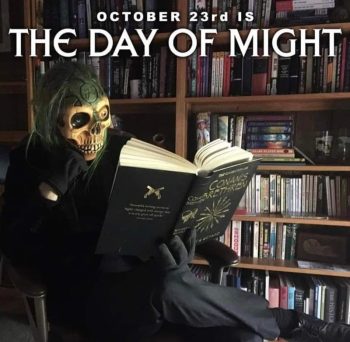

I have been grateful to HAJ for many years, from being a fan of his S&S blogs and appearances at World Con 2010, to meeting him at Gen Con and having him coach me into volunteering at the Writers Symposium ~2017 (which grew into me chairing it in 2023), for bridging the connection to John O’Neill to edit for Black Gate online magazine (~2019 onward), and for being able to intern for his magazine Tales From the Magician’s Skull as acquisition editor and for being a social media intern for the Skull (~2022).
The outpouring of memorials speaks to HAJ’s character and influence. Each instance, even the shorter obituaries, amplifies his life and reveals nuances. Below I list several so I, and anyone visiting here, can learn more about the man we miss. There are many more tributes than those listed below. More may be added after the original posting date as I track those down.
Did you know Howard… was once a TV cameraman? Created an official Walk Through Guide for a Castlevania game? Coined New Edge Sword & Sorcery?- Locus: abbreviated verionHoward Andrew Jones (1968-2025); longer version by CSE Cooney, John O’Neill, John Hocking, Matthew John, Scott Oden) available in Issue 769 also inside the celebration display p16.
- SFWA: In Memoriam: Howard Andrew Jones [John O’Neill, SE Lindberg, Martha Wells, Sean CW Korsgaard]
- Joseph Goodman (Skull publisher) A Tribute to Howard Andrew Jones
- John ONeill (Black Gate): Howard Andrew Jones, July 19, 1968 – January 16, 2025
- Jason Ray Carney: Howard Andrew Jones, a Mentee’s Perspective
- Bob Byrne An Important Life – Howard Andrew Jones (1968 – 2025)
- Brian Murphy: Rest in peace, Howard Andrew Jones
- Sean CW Korsgaard This is one of the hardest things I’ve had to write in my career. Howard Andrew Jones is dead
- Mark Rigney (Celebration of Life farewell)
- Greg Mele: “Swords Together, buddy” Private Facebook Post
- Matt John — Devastated to learn my friend, Howard Andrew Jones, has passed.
- Deuce Richardson (DMR) Howard Andrew Jones Has Fought His Last Battle
- Vanessa Armstrong Author Howard Andrew Jones Passes Away at Age 56
- Michael Grossberg Acclaimed fantasy writer and Prometheus finalist Howard Andrew Jones, R.I.P.
- Paizo (Pathfinder) Paizo Remembers Howard Andrew Jones
- Morgan Holmes Remembering Howard A. Jones
- Keith West RIP, Howard Andrew Jones
 Howard Andrew Jones’ Office in Evansville
Heroes really are out there. They’ve lived and breathed and sacrificed right here on this very Earth, and some of them are still at it. Students of history know them. Sometimes we can even find them covered by our local news stations. Stories of heroes, not of dejected mopers, have inspired us since the dawn of humanity, and we should not be embarrassed if they continue to fire our imagination. — HAJ 2008
Howard Andrew Jones’ Office in Evansville
Heroes really are out there. They’ve lived and breathed and sacrificed right here on this very Earth, and some of them are still at it. Students of history know them. Sometimes we can even find them covered by our local news stations. Stories of heroes, not of dejected mopers, have inspired us since the dawn of humanity, and we should not be embarrassed if they continue to fire our imagination. — HAJ 2008
S.E. Lindberg is a Managing Editor at Black Gate, regularly reviewing books and interviewing authors on the topic of “Beauty & Art in Weird-Fantasy Fiction.” He has taken lead roles organizing the Gen Con Writers’ Symposium (chairing it in 2023), is the lead moderator of the Goodreads Sword & Sorcery Group and was an intern for Tales from the Magician’s Skull magazine. As for crafting stories, he has contributed eight entries across Perseid Press’s Heroes in Hell and Heroika series, and has an entry in Weirdbook Annual #3: Zombies. He independently publishes novels under the banner Dyscrasia Fiction; short stories of Dyscrasia Fiction have appeared in Whetstone, Swords & Sorcery online magazine, Rogues In the House Podcast’s A Book of Blades Vol I and Vol II, DMR’s Terra Incognita, and the 9th issue of Tales From the Magician’s Skull.
Maggie The Undying: Title Reveal
We interrupt this scheduled broadcast with breaking news.


Text of the Announcement:
This Kingdom Will Not Kill Me by Ilona AndrewsGame of Thrones meets Outlander in This Kingdom Will Not Kill Me
When Maggie wakes up, cold, naked, and filthy in Kair Toren, a city in the kingdom of Rellas, she recognizes it immediately. It’s the world she knows intimately from the pages of an unfinished dark fantasy series she’s been obsessively reading and re-reading while waiting years for the final novel. With no idea how or why she landed in this gritty, violent world, she’s determined to survive until she can figure out how to get home with her only tools – an encyclopedic knowledge of the plot, setting, and the characters’ actions, motivations, and fates: information she can sell to the highest bidder – all while staying under the radar so as not to change the very information she plans to barter.
Soon Maggie discovers another surprising “skill”: she cannot be killed (though many will try.) And as she becomes more attached to the motley band she’s somehow gathered – which includes a former lady’s maid, a deadly assassin, a dangerous soldier, and various outrageous magic creatures – she abandons all thoughts of lying low for her own good. Instead she finds herself trying to save them, and the Kingdom of Rellas from the cataclysmic war she knows is coming.
And then there is a nice paragraph about us and our writing stuff.
To reiterate:
Series title: Maggie the Undying.
Book 1 Title: This Kingdom Will Not Kill Me.
Book 1 Release date: March 31, 2026
Why is this announcement happening now?
Because TOR has learned that the Book Devouring Horde is not to be denied. They were planning to keep the title and release date under wraps until we had the cover, but it was concluded by all that since this book will be presented at London Book Fair next week, BDH will surely find out the details and will blast them all over the internet.
Congratulations, you are mighty!
How dark and gritty is this?
As we are finishing up the edits – page 649 of 808 – actually, not that dark and gritty. The Game of Thrones in the blurb above refers to the epic fantasy nature of the series and the Outlander reference is about the portal nature of the books, where the main character is transported into another world.
There are some tough scenes, but it’s nothing that exceeds our usual. If you’ve read Kate Daniels or Hidden Legacy, you should be fine. There is no on page rape, although sexual assault does happen in this world. The book overall has an uplifting trajectory.
Is this truly a fantasy?
Yes. Knights, assassins, weird magical beasts, swordfights, unhinged mages, the whole thing. This is meant to be a world of epic fantasy tropes.
Is there romance?
Yes. There is a romantic arc, but this is not a romance. This is an epic fantasy. That said, if you are a romance reader, you will likely enjoy this.
Is this one of those stories where it was all a dream and she wakes up and nothing changed and she is back in her own world…
No. I hate the dream thing. Not a dream. We would not put you through an emotional wringer to just then make it not matter.
That’s it. More to come, as our agent likes to say.
PS. Mod R has a fun post which will go out on Monday.
The post Maggie The Undying: Title Reveal first appeared on ILONA ANDREWS.
Lights Out - Book Review by Voodoo Bride
 Lights Out (Into Darkness #1)by Navessa Allen
Lights Out (Into Darkness #1)by Navessa AllenWhat is it about:I want someone with a soul as black as night. Someone who would burn the world down for me and not lose a single minute of sleep over it.
Trauma nurse Aly Cappellucci doesn’t need any more kinks. She likes the one she’s landed on just fine. To her, nothing could top the masked men she follows online. Unless one of those men was shirtless, heavily tattooed, and waiting for her in her bedroom. She dreams about being hunted by one in particular, of him chasing her down and doing deliciously dark things to her willing body. She never could have guessed that by sending one drunken text, those dreams would become her new reality.
I want things most people don’t, craving darkness and depravity instead of light and love.
Josh Hammond has spent his life avoiding the limelight, but his online persona is another story. At night, he posts masked thirst traps for his millions of fans to drool over, but one follower has caught his eye: Aly. After reading a comment begging him to break into her house wearing a mask, he decides to take her up on her offer.
Together, Aly and Josh live out their darkest fantasies, unaware that Aly has captured the attention of someone else. Someone with far more sinister intentions than a little light stalking. As Josh turns from predator to protector and the stakes heighten, he must ask himself how far he’s willing to go for the woman he’s obsessed with.
What did Voodoo Bride think of it:*Might be a tiny bit spoilery*
Either I'm more depraved than I thought, or there needs to be a serious discussion about what a Dark Romance is.
Because this wasn't dark at all in my opinion!
Not that that was a bad thing: I haven't laughed so much while reading a Romance in a long time. And not because the story is laughable, but because it really is meant to be funny.
I liked Aly and Josh from the start. Josh is a bit of a social disaster, but otherwise they're both just really fun people. I enjoyed learning more about them and seeing them fall for each other.
There were two minor annoyances:1 - Even though their backstories were entertaining, I didn't like it that those were used as an explanation for their kinks. You don't need a trauma or tragic event to enjoy kinks.2 - Saying "No safe word. Just say stop, and I'll stop." = a safe word!!!!!But those were minor as I said. I could easily put it aside for the sake of the story.
All in all I had a great time with this, and even Sullivan got invested when real danger was introduced to make things a bit more suspenseful. He also really liked Fred, the cat.
You bet we will get hold of the next book.
Why should you read it:It's a very enjoyable Dark Romance
Comment on A Beginner’s Guide to Drucraft #31: Sigl Recycling (I) by Tony
In reply to Tony.
*Essentia, stupid autocorrect
Comment on A Beginner’s Guide to Drucraft #31: Sigl Recycling (I) by Tony
I thought the answer would probably have something to do with filling wells. Wonder if there’s a primal effect to help homogenise essentially as it’s added?
Novella Review: Murder by Memory by Olivia Waite
I received a review copy from the publisher. This does not affect the contents of my review and all opinions are my own.
 Murder by Memory by Olivia Waite
Murder by Memory by Olivia Waite
Mogsy’s Rating: 3 of 5 stars
Genre: Science Fiction, Mystery
Series: Book 1 of Dorothy Gentleman
Publisher: Tordotcom (March 18, 2025)
Length: 325 pages
Author Information: Website | Twitter
I’d never read Olivia Waite before, but apparently she’s known for her romance writing. In Murder by Memory, she’s managed to successfully blend elements of a love story with a cozy mystery set on a generation ship—not genres you often see thrown together in the same mix. Still, while tackling it in novella form may have made this one a quick read, I think the shorter length probably hobbled its potential.
The story kicks off when Dorothy Gentleman, detective on starship H.M.S. Fairweather, wakes up unexpectedly in the middle of their centuries-long journey. In addition to thousands of passengers, the vessel is also carrying a vast digital archive, the “Library”, where their memories have been uploaded and stored in “books.” These books can be updated at any time, ready to be downloaded into a person’s new body that is provided once their old one dies.
When Dorothy awakens, however, she had not expected to be downloaded into a new body so soon, for she had chosen to shelve her memories for a few years. Not only that, but the new body she finds herself in is not her own, but a stranger’s named Gloria. The ship’s A.I. informs our protagonist that there has been a death on the ship, and someone has also been deleting memory archives from the Library. Along with the unusual circumstances she now finds herself in, these incidents are more than likely connected. To solve the murder and figure out why her memory book was erased—which has resulted her being in the wrong body—Dorothy must step into her detective shoes and investigate, using her skills and the element of surprise to her advantage.
Without a doubt, the greatest strength in Murder by Memory is the world-building. While the concept of effective immortality by uploading the consciousness and downloading it into new bodies isn’t new, I have never seen it used in a cozy setting like this. In fact, the stories I’ve read that are set on generation ships tend not to be very pleasant, weighed down by themes like scarcity and uncertainty. But the world Waite has created is perfectly copacetic. Which is why the idea of a murder, especially one like this, feels like such a big deal.
The mystery plot itself was also solid, but unfortunately, the constraints of the novella’s short length were noticeable. There was no room for the story to be anything but straightforward, making the investigation feel rushed and lacking in complexity. While we moved quickly from clue to clue, the absence of any intrigue left the resolution feeling a bit sudden and too easy. Likewise, Dorothy was an enjoyable protagonist, and there were certainly moments of humor reading about this older lady adjusting to a more youthful body, but the story’s brevity also meant that her development was somewhat sparse, and I barely registered any of the side characters.
Ultimately, Murder by Memory was a fun read, but despite some of its unique qualities, I doubt it will leave a lasting impression. That said, as the opening volume of a new series, I think it has potential. Over time, I can see future sequels building upon each other, fleshing out the world and bringing more depth to Dorothy’s character. And if these episodes will be as short and sweet as this one, I’ll be keeping an eye out for the next book and hoping it expands on the foundations laid here.
![]()
![]()
Goth Chick News: Corpses, Monsters and a Giraffe Onesy – Hitting the Road to TransWorld 2025
 TransWorld’s Halloween & Attractions Show 2025
TransWorld’s Halloween & Attractions Show 2025
Around this time every year, Black Gate photog Chris Z and I pack up the car for the 10-hour-round-trip from Chicago to St. Louis to attend the TransWorld Haunted Attractions Show. This event not only kicks off the spooky season for the new year but never fails to produce at least one memorable adventure. From Fireball shots to epic snowstorms, to celebrity encounters, I can always count on our annual road trip to produce stories that will easily carry me through a year’s worth of cocktail-party small talk.
This year was no exception.

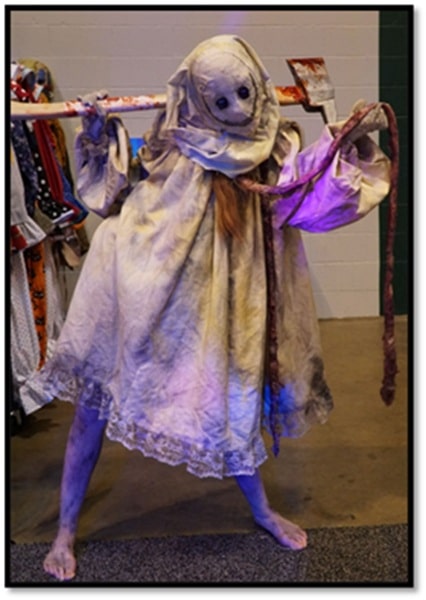
Seen at the TransWorld Halloween & Attractions Show 2025. Photos by Chris Z
For a start, our odyssey begins with me picking up Chris Z at 5am to ensure we are in St. Louis when the show doors open at 10. This has been the standard operating procedure for the eighteen years we have been covering this show, except for the couple of years TransWorld was held here in Chicago. Every year, Chris Z complains about the early pickup time, threatening to show up in his pajamas and sleep the entire five hours; and every year I tell him to nut-up and promise to stock the car with Mountain Dew.
So, last weekend at 5am I roll up into his driveway, noticing there is some kind of cord laying in front of his garage door, and remind myself to tell him when he comes to the car. At that moment, the darkness of the suburban neighborhood is shattered by a disco light display worthy of Saturday Night Fever. My stunned brain seized up, my mouth dropped open, and before I could figure out what the heck was happening, the garage door lifted to reveal Chris Z in a giraffe onesy.
As I have no further words to describe this, so here…


Chris Z in a onesy
Yes, apparently Amazon really does have everything.
Chris Z loads his camera gear in the back seat, gets in, and curls up – all in silence. An hour later when we stop to recaffeinate, he strolls into the Starbucks in said onesy and blithely orders like this is something he does every day. To the credit of the baristas, they just looked at each other and kept right on working. Back at the car, Chris Z shed the onesy saying only that it was making him too hot.
…sigh.
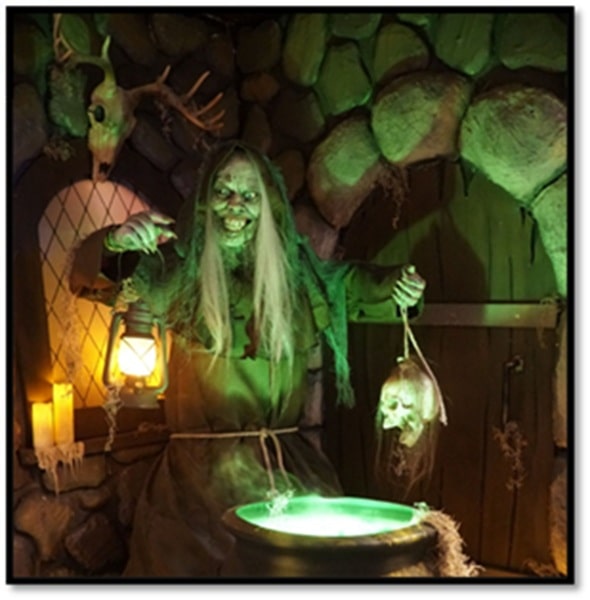

Photos by Chris Z
Now, about the TransWorld show and why thousands of Halloween tradespeople fly from all over North America to get their spooky on in February.
TransWorld is an “industry only” event not open to the public. It brings together professional haunt operators and the suppliers of everything from costumes and makeup, to $20K special effects.
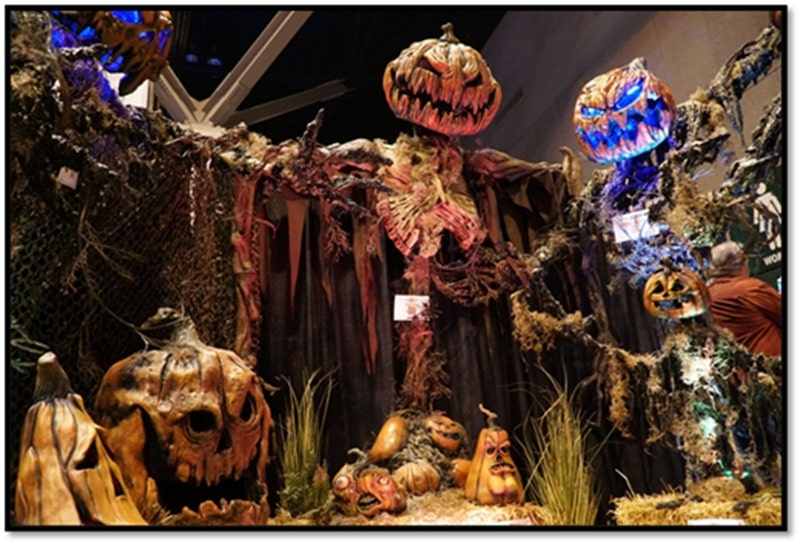 Scenes from TransWorld’s Halloween & Attractions Show 2025
Scenes from TransWorld’s Halloween & Attractions Show 2025
Ever wonder where amusement parks like Cedar Point and Great America, or big-name haunted attractions get their gear? TransWorld is the place, and with the haunt industry estimated at $30 billion annually, the vendors who have booths at TransWorld are the absolute real deal. Also, since creating and shipping all these scares takes time, the flurry of activity happens in February to ensure everything is in place by fall.
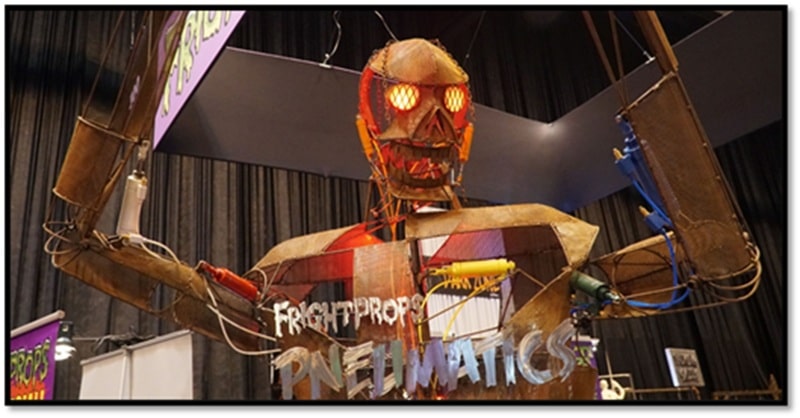 Frightprops Pneumatics
Frightprops Pneumatics
Walking into TransWorld, held at the Americas Center is stepping into 500,000 square feet of creativity and horror. Imagine rows upon rows of booths showcasing hyper-realistic props, cutting-edge animatronics, custom soundscapes, and theatrical-grade special effects. One of the highlights of each year is getting an early look at the new technology that keeps the haunted attraction industry fresh and terrifying. Innovations like AI-driven scares, augmented reality overlays, and hyper-detailed silicone masks demonstrate the evolution of horror craftsmanship.
TransWorld is more than just a trade show; it’s a masterclass in the haunt industry. The event features an array of seminars, workshops, and panels led by industry veterans. Topics range from the art of creating compelling narratives for haunted houses to practical advice on marketing, ticketing, and safety protocols.
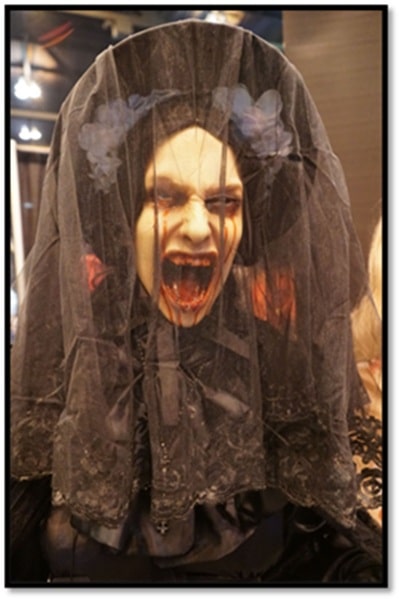
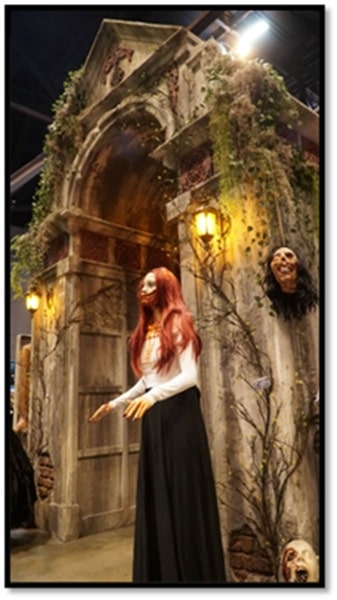
Seen at TransWorld. Photos by Chris Z
For haunters who want to experience the thrills firsthand, the event hosts live demonstrations and walkthrough attractions. These mini-haunts showcase the latest in set design, scare techniques, and interactive storytelling. Walking through these exhibits is like getting a sneak peek at the nightmares that will soon populate attractions nationwide.
Perhaps the most compelling aspect of TransWorld is the community it fosters. Chris Z and I consider it our annual “family reunion” where we connect with artists we’ve covered for nearly two decades and get the scoop on their newest ventures.
We couldn’t kick off spooky season without checking in with my long-time goth boy-band crushes, Ed and Gavin of Midnight Syndicate. Best known for their dark, atmospheric soundtracks they have become staples in the haunted attraction industry.
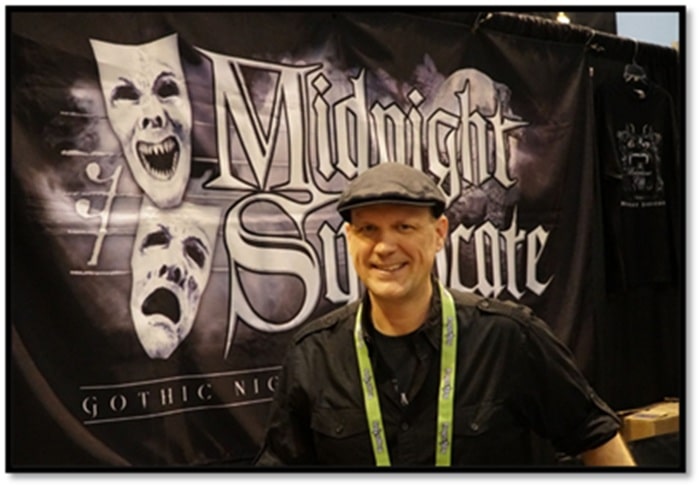 Goth Boy-Band Crush: Midnight Syndicate
Goth Boy-Band Crush: Midnight Syndicate
Since their formation in 1997, Midnight Syndicate has created the soundtrack for haunt season, providing music for Universal Studios Halloween Horror Nights and hosting their own stage show at Cedar Point’s Halloweekends.. We absolutely love Ed and Gavin’s music and were excited to learn they have a new album coming out later this year. We are always honored to get an early listen, so stand by for more.
 Demski Creations
Demski Creations
We also checked in with Brian Demski of Demski Creations. Brian is a seasoned artist with over two decades of specializing in creature special effects, custom prop fabrication, and scenic design. He has contributed to feature films, television, music videos, and haunted attractions, and his work is characterized by a macabre aesthetic, often incorporating steampunk elements. Having first interviewed Brian for Black Gate back in 2011, when I acquired my first Demski original, it has been incredible seeing the evolution of his talent first hand.
Last but never least we had a chance to catch up with John Weisgerber, owner of the Gemini Company. John didn’t have a booth this year, but we loved hearing about his latest creations. The Gemini Company specializes in museum-quality replicas sculpted and/or molded from actual specimens and cast in high quality materials and resins. Gemini pieces can be seen in shows such as American Horror Story and Mysteries at the Museum and I am the proud owner of a very realistic shrunken head which attends all my Teams meetings. Gemini also has a great Etsy page and I’m eyeballing that evil little doll from Trilogy of Terror.
 That creepy little doll from Trilogy of Terror (replica by The Gemini Company)
That creepy little doll from Trilogy of Terror (replica by The Gemini Company)
So spooky season 2025 has officially kicked off and I couldn’t be more excited. By the way, I never considered a giraffe to be an element of horror – until now.
Spotlight on “When We Were Real” by Daryl Gregory
When We Were Real is a madcap adventure of two friends on a cross-country bus…
The post Spotlight on “When We Were Real” by Daryl Gregory appeared first on LitStack.
On McPig's Wishlist - A Dagger of Lightning
 A Dagger of Lightningby Meredith R. Lyons
A Dagger of Lightningby Meredith R. LyonsLet's get one thing straight: I am not your chosen one.
Forty-five-year-old Imogen has always struggled to fit in, never finding her passion in life. And while that may include having cold feet in her impending nuptials, that doesn't mean she's ready to ditch planet Earth—and her entire life—completely.
When Imogen is kidnapped by an alien prince in disguise, there’s nothing she can do to stop him. He’s sidhe—a being with powerful abilities—and he’s grown up used to getting what he wants. The prince is convinced Imogen will fall in love with him, and that her new powers, once she’s turned sidhe, will help his country win a centuries-old feud.
With the help of the prince’s much more tolerable brother, Imogen starts to get her feet back under her, but even he can’t protect her from those who would use her for her powers. If Imogen can’t find a way to fight for herself, she’ll become a pawn in a world that has already decided what she’s going to be.
Expected publication April 1, 2025
And Now For Something Completely Different: The Borrowers, by Mary Norton
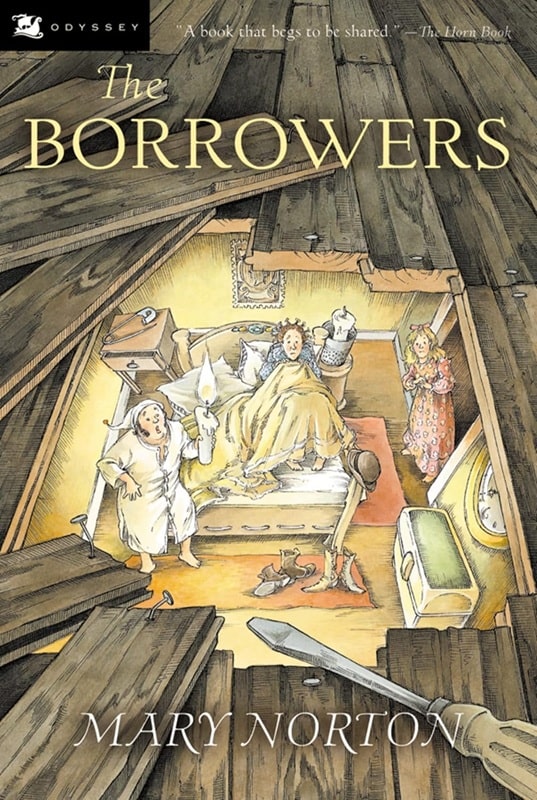

The Borrowers and The Borrowers Afield, by Mary Norton
(Odyssey/Harcourt, January 1998). Covers by Marla Frazee
I’ve done four posts in a row on Edgar Rice Burroughs, with more to come. But right now it’s time for a change of pace.
It’s going to be a big change for this particular post. It’s about The Borrowers. In my late teens, after I learned Andre Norton was a woman, someone told me she’d written books under her own name of Mary Norton, and that one was called The Borrowers. Turns out this wasn’t true; her original name was Alice Mary Norton, although she changed it legally to Andre Alice Norton in 1934. This was in the late 1970s, pre-internet, and I believed Andre Norton wrote The Borrowers for several years. It added to her charm for a while because I’d read The Borrowers when I was 11 or 12 and adored it.
The Borrowers may seem pretty far afield from Sword & Planet fiction, but the story of little people living in human houses and borrowing things from them, which would explain why things got “lost,” inspired my imagination and I invented many stories of myself shrunk down to that size and adventuring. After I wrote Swords of Talera, my first S&P novel, I toyed with the idea of writing an S&P story with borrower size characters but never did. Many many years later I discovered a graphic novel from DC called Sword of the Atom, which somewhat scratched that itch for me. (More on that later.)
[Click the images for non-Borrower-sized versions.]
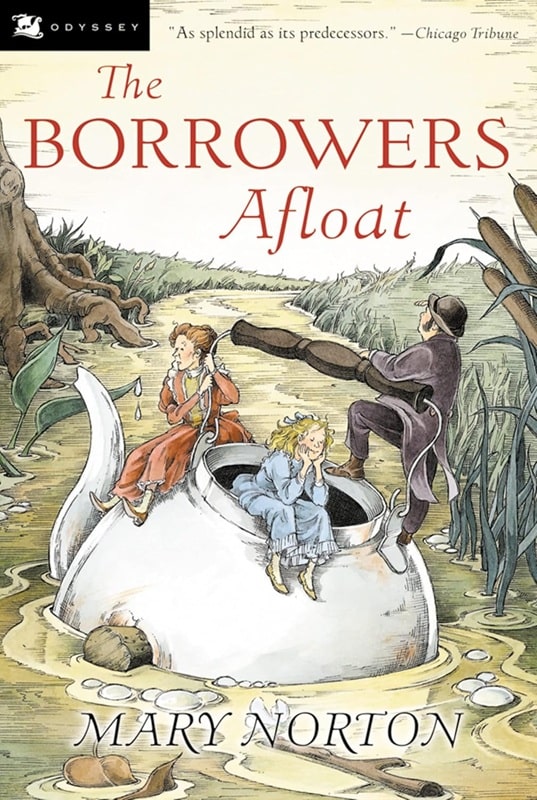
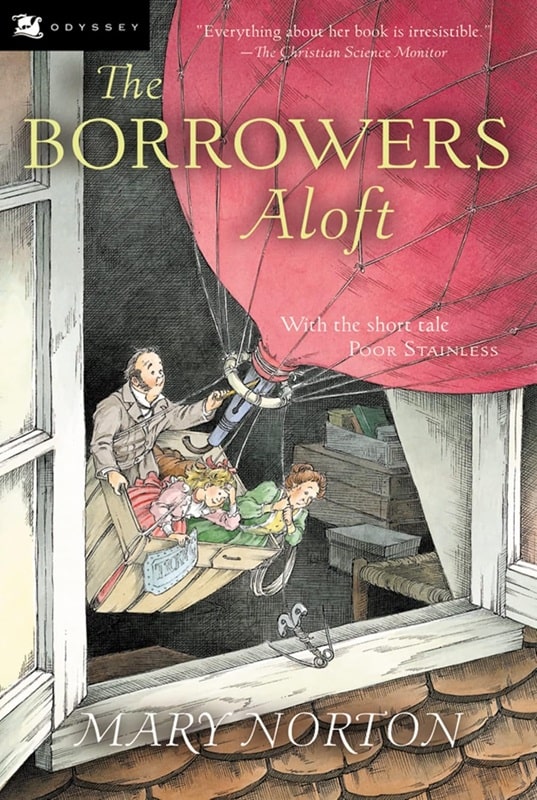
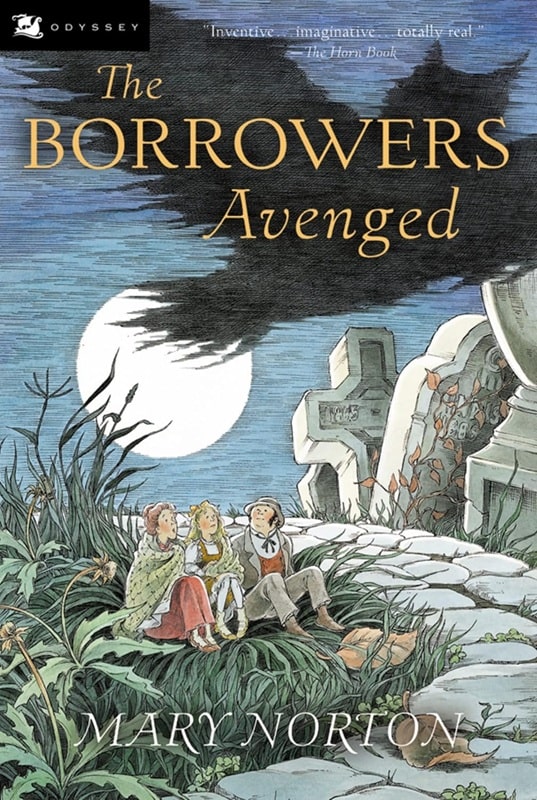
The Borrowers Afloat, The Borrowers Aloft, and The Borrowers Avenged
(Odyssey/Harcourt, January 1998). Covers by Marla Frazee
I got The Borrowers from our local library and only found out as an adult in my thirties that there were three later books in the series. These are: The Borrowers Afield, Afloat, and Aloft. I still remember being irritated at our library for not having those too. I would have devoured them.
This happened to me with other series I would have read more of at the time, including The Three Investigators (I thought there were just 2), The Hardy Boys (I only saw 3), and Doc Savage (I thought there was only a couple).
I picked up my own copy of The Borrowers many years ago, and later got The Borrowers Afloat, but after thinking about this post I went and ordered Afield and Aloft, and then discovered that Mary Norton wrote a fifth sequel 20 years after Aloft called The Borrowers Avenged. I ordered that one too. I just finished reading Afield and Aloft and they had all the charm and fun of the original.
I’m reading Avenged now. The first two I have are ex-library copies but I bought the other three are new. The older ex-library editions have wonderful covers and interior illustrations by Beth and Joe Krush. I particularly love The Borrowers Afield cover, by Marla Frazee. Totally ignites my imagination.
Charles Gramlich administers The Swords & Planet League group on Facebook, where this post first appeared. His last article for Black Gate was The Fiction of Edgar Rice Burroughs, Part IV: The Hollow Earth and Pellucidar.


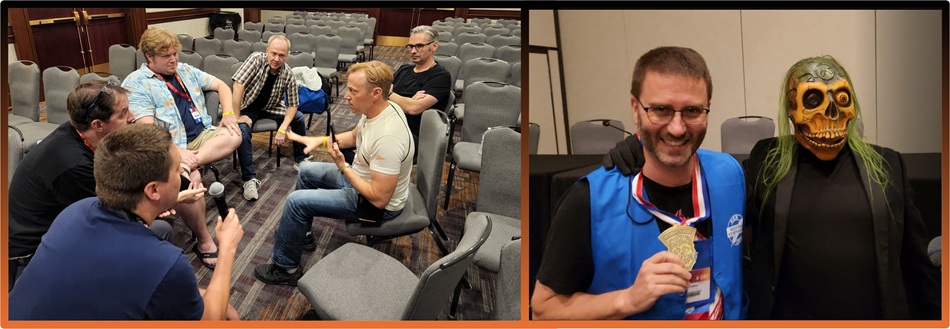
Recent comments